- Hospitality Industry

Top 10 Trends in the Hospitality Industry in 2024
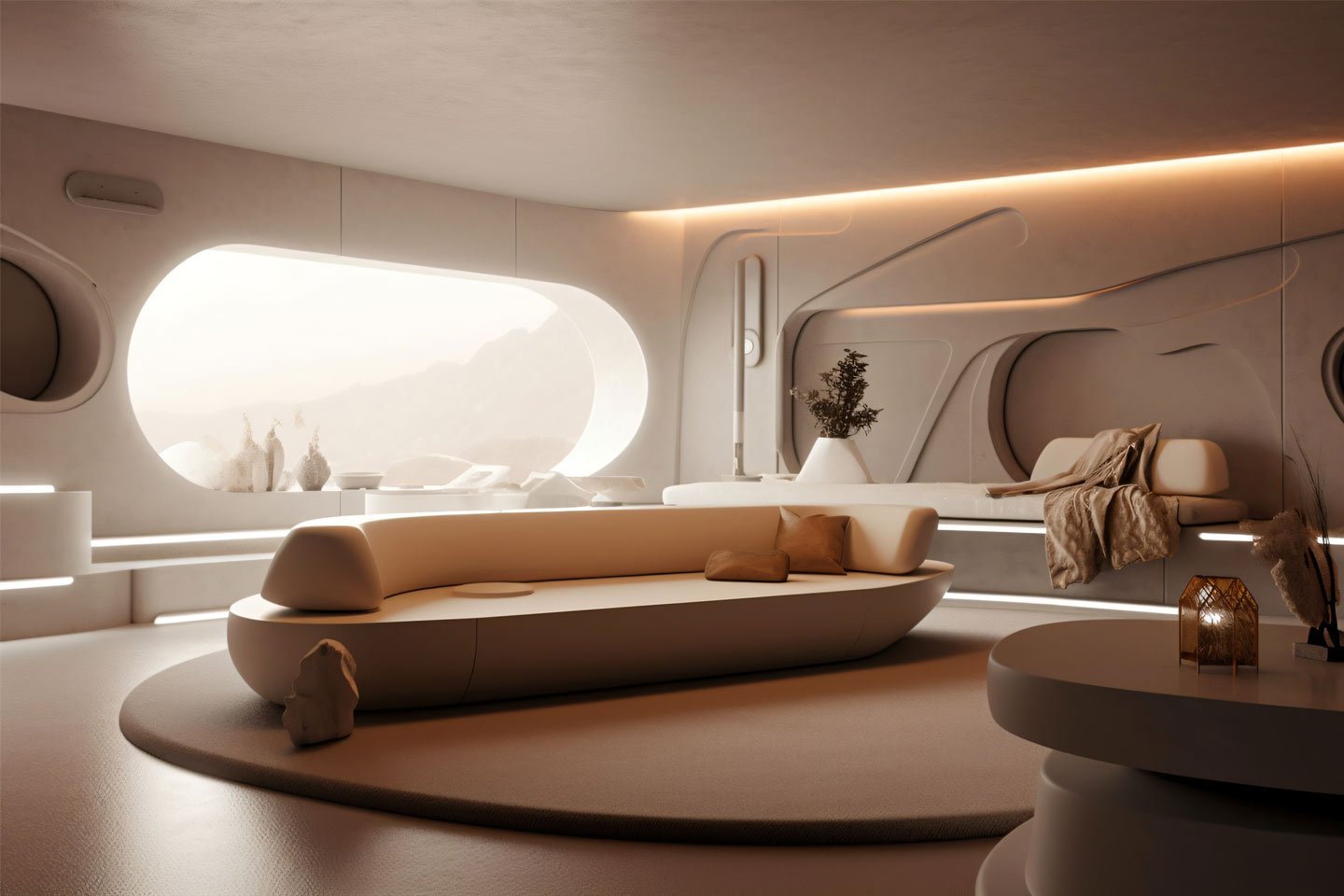
January 10, 2024 •
15 min reading
What are the latest trends in the hospitality industry? As a testament to its resilience, agility and innovative spirit, this article reflects today’s increasingly dynamic hospitality industry in terms of its long, medium and short-term evolution. Discover the industry's adaptability and forward-thinking approach, shaping its trajectory in the face of challenges and opportunities, while staying attuned to the latest hospitality trends.
Best-selling author, Will Guidara, claims “We are entering into a hospitality economy” – suggesting that what underpins the essence of hospitality, (service excellence, human interaction, personalization and the co-creation of memorable experiences), is actually what many sectors of industry are desperately in need of today.
As we charge at break neck speed towards an ever-more digitalized society , the hospitality industry stands out as the successful hybrid that balances the implementation of tech innovation for improved operations whilst preserving the human need for connection, authenticity and real-life discovery.
With statistics predicting a healthy expansion of the sector (e.g., the bleisure and wellness markets on the up, room demand set to reach an all-time high, booking.com as the most valuable tourism brand in the world, and new positions opening up in the sector), we can confirm that the hospitality industry is poised for a significant transformation in 2024.
So what new trends are emerging? Driven by interlinked factors, including technological progress, evolving consumer preferences and a deeper focus on sustainability, hospitality businesses can capitalise on emerging opportunities to enhance guest experiences and position themselves for long-term success.
10 hospitality trends 2024 - Elevate experiences, embrace evolution
- Workforce empowerment: Transforming challenges into opportunities
- Artificial intelligence and technology: Choosing the best tech to revolutionize hospitality
- Culinary experiences: Putting experiences, authenticity and the senses first
- Bars and drinks redefined: Adding creativity and design to the drinks' menu
- Fine dining: In need of reinvention but full of potential
- Fine wine prices: Navigating the fluctuating vineyard market
- Rising interest rates: The impact on hotel property values and transactions
- Green hospitality: Beyond sustainability to net positivity
- Data-driven decision-making: Data-analytics for optimum personalization
- The power of social media: Crafting authentic narratives
1. Workforce empowerment: Transforming challenges into opportunities
Over the past two years, the industry's biggest challenge has not been attracting customers but rather finding and retaining staff. To address this issue, many hotel groups have begun to make improvements, and there has never been a better time for newcomers to the industry to negotiate better working conditions and salaries.
Today, many hotels offer their staff free or low-cost accommodation , increased wages and reduced peak-time working hours. They also invest in training programs to motivate staff and allow mobility up the corporate ladder. Empowered employees not only have a positive impact on how guests feel and their decision to become repeat guests, but also help attract other employees to build a cohesive, high-quality workforce.
2. Artificial intelligence and technology: Choosing the best tech to revolutionize hospitality
As Chat GPT celebrates its first birthday, we can only surrender to the fact that, like it or not, we have entered into an AI-accelerated world, and consequently, the pace at which the industry adapts has become a pressing issue. But which forms of AI best harness hospitality stakeholder outcomes?
Contactless services: Effortless technology, impeccable stay
Embracing contactless technologies is about redefining the hospitality experience to cater to modern travelers, not just adapting to the pandemic-driven shift toward touchless interactions. Contactless services simplify the guest journey by reducing wait times and physical contact points. Mobile check-in, digital keys and voice or tablet-controlled room automation allow guests to move seamlessly through the hospitality experience. The citizenM hotel brand has pioneered this minimum-fuss check-in and room experience with a hugely successful UX-friendly app.
Other popular tools such as WhatsApp allow hotel staff to remain in constant contact with customers during their stay, respond immediately to requests and thus provide bespoke services. It also streamlines operations by reducing the need for face-to-face interactions and human error, improving service delivery and lowering the burden on a scarce workforce. In line with contactless services , hospitality companies need to prioritise data privacy and security, putting solid safeguards in place to protect guest information against cyber threats.
Technology-driven innovation: Beyond boundaries
At the heart of technology innovation is the ability for managers and employees to centralize information at all times. Migrating to a fully cloud-based solution is a first but essential step . This enables real-time sharing, better service orientation and personalisation of the guest experience, improving all hotel departments.
Robotic systems (as used in the Henn-na Hotels in Japan) optimise processes and increase efficiency in back-of-house operations such as housekeeping or F&B outlets, reducing staffing requirements and allowing managers to respond to problems in real-time and with accountability.
The use of augmented reality helps with staff onboarding, allowing new employees to be put in real-life situations and trained before even entering a room. Pedagogically speaking, as practiced at EHL in the Virtual Housekeeping class, AR provides a more interactive and complete learning environment. Augmented reality also allows hotels and airlines to market themselves in an ad hoc style - an innovative and sustainable approach. Potential customers can better immerse themselves in the facilities and make more informed decisions.
Hyper-personalization: Tailored moments, lasting loyalty
In a world of commoditised practices, guests are increasingly looking for personalized experiences that cater to individual preferences and aspirations . In the hospitality industry, hyper-personalisation means relying on technology-based micro-segmentation to tailor each guest interaction to real-time needs and behaviours. For example, eliminating 'deadlines' such as check-in/check-out/F&B closing times, knowing whether a customer wants to be accompanied through check-in or do it contactless, personalizing room temperature, lighting and amenities or tailoring F&B options promptly and accurately. At Fauchon l'Hotel in Paris clients suggest the menu and define their portion sizes. From a hotel perspective, this enables better dynamic pricing strategies, higher guest-spent for experiences, or tailored loyalty programmes with commercial partners.

3. Culinary experiences: Putting experiences, authenticity and the senses first
The desire to experience rather than simply consume means that experiential dining has today evolved in new ways. Hotels are now required to offer a range of dining options to cater to different customer tastes and, when correctly done, can become a culinary destination where the restaurant is at the heart of the experience and not just an extension of the hotel. A good example is the Grand Resort Bad Ragaz in Switzerland which boasts seven restaurants, three bars, a bistro, a café and a sushi takeaway, (plus an array of Michelin stars and GaultMillau points), unsurprisingly making it a mecca for traveling gourmets.
Experiential design can also allow customers to taste food in a multi-sensory environment that stimulates all the senses, not just the taste buds (e.g., Ultraviolet by Paul Pairet in Shanghai ). Some hotels have started to provide experiences even on a smaller and more dynamic scale. E.g., They offer four-hand dinners (an invited chef cooks with the in-house chef), organise kitchen parties (clients eat in the kitchen), or have a front-cooking area. Specialist cooking classes can complement this. The key here is to offer a unique experience like how to make your own gin, cook local food , or bake bread with the experts.
Another trend relates to children . A menu of unimaginative, standard food à la burger and chips is no longer enough; parents want their children to eat healthier, globally-inspired food with high-quality ingredients. Adding world food or plant-based products and packaging them in innovative ways will make for happy families likely to return.
A final significant trend in the food sector is off-premise dining and digitalisation. Although customers have returned to eating in restaurants since the pandemic, a large proportion mix on- and off-premise dining. Restaurants need to cater to this clientele to increase revenues, as takeaways are no longer limited to fast food but also exist for traditional and even fine dining. This means that restaurants need to reorganise their workflows and operations to cater to in-house diners and delivery, alongside designing appropriate, creative, high-quality packaging and optimising delivery or collection methods to be easy and inexpensive without competing with traditional delivery platforms.
This can also include ghost kitchens focusing only on food production for delivery and takeaway. Post-Covid, ghost kitchens have become an increasingly popular trend in the restaurant industry with statistics showing that they are projected to be a $157 billion market by 2030. As of 2021, there are over 100,000 ghost kitchens operating worldwide .

4. Bars and drinks redefined: Adding creativity and design to the drinks' menu
Today's bars need to stand out by offering unique drinks paired with a special, Instagrammable atmosphere to create an immersive experience for their customers. E.g., Ashley Sutton Design Bars are known across Asia for their ability to transport guests to enchanting, immersive worlds, offering not just a place to drink but an entire experience that stimulates the senses and sparks curiosity.
Gone are the days of a simple wine list and international beer and spirit brands. Bars and restaurants need to specialise and cater to an international clientele with evolving tastes. A dedicated beer menu with local craft beers, wines from specific vintages and terroirs with a narrative, eclectic spirits collections (after whisky and gin, look out for rum in the coming years), and fresh hyper-locally sourced juices are what customers want.
Mixology has been around for some time, but offering mocktails and non-alcoholic food pairings is also becoming essential due to stricter alcohol laws and healthier lifestyles driven by Gen Z and millennials. Faux booze has gone mainstream and now it’s not just a case of ‘dry January’, but mocktails all year long! Cocktail and mocktail innovations should go beyond traditional recipes to include unique ingredients, techniques and presentation styles (e.g., Bar Benfiddich in Tokyo ) and be taught to customers in mixology classes.

The effect of economic uncertainty on hotels, restaurants and fine wines
5. fine dining: in need of reinvention but full of potential.
The pandemic has unexpectedly affected consumer behaviors: they now organize themselves on short notice, have become increasingly spoilt for choice and no-shows are today the norm . More and more restaurants are responding by asking for a credit card at the time of reservation. But this only treats one of the symptoms without solving the problem. "A full house one day, but only four tables occupied the next" , is an observation that led Antoine Lecefel to shut his restaurant – sadly one of many fine dining establishments to do so.
Inflation and declining purchasing power play a part, but more generally, the fundamental problem lies in the inability of fine-dining restaurants to reinvent themselves. Unlike hotels and other players in the hospitality industry that increasingly compete with them through ambitious and innovative culinary projects, they have to contend with limited financial and human resources. They have neither the capacity to implement and manage a proactive strategy nor the means to invest in cutting-edge, highly experiential concepts. Initiatives such as Eatrenalin , which create a unique experience by combining gastronomy, décor and entertainment, offer a glimpse of this changing industry and the new competition facing traditional players.
Solutions? A strong, contemporary concept plus a business-oriented management that understands consumers, connects with them and is thought through from the outset to generate margins and create synergies and/or economies of scale. The Igniv chain is a shining example of this, driven by an extraordinary chef and based on the principle of “we love to share”, Andreas Caminada has created a unique and fully coherent concept, the success of which is now being rolled out in various locations, all of which have been rewarded with rave reviews from customers and expert guides.
6. Fine wine prices: Navigating the fluctuating vineyard market
Another challenge facing restaurants is cellar and wine list management. Restaurants with limited financial resources may even wonder whether fine wines still have their place on their menu . Indeed, fine wine prices have risen almost exponentially since the Global Financial Crisis of 2008. But here, too, the situation appears to have changed.
A year ago, fine wine prices were at record highs. Demand for rare, artisanal wines from regions with long-standing terroir reputations was at its peak. One could go on about Burgundy, but many other examples are as revealing. For example, the Châteauneuf-du-Pape Réserve cuvée from Rayas, worth between 150 and 200 euros (for young vintages) less than a decade ago, has soared to reach and exceed the 2’000 euro mark. At this point, voices suggested that this was normal; inflation should also positively impact the prices of fine wines. But there is no reason this should be the case: demand drives prices, not production costs. Fine wines attract wealthy people, collectors and investors. For them, the resources that can be invested in wine depend on economic conditions and financial markets. The latter have fallen sharply since the beginning of 2022. Not surprisingly, wine prices have followed the same trend.
The most spectacular move was in Burgundy wines. Prices had become so high that these wines had detached from the rest of the market. Just a year ago, many wines from the 2019 vintage were selling for several thousand euros a bottle. One wondered whether these wines had permanently changed their status and would never be traded at lower prices again. Today, the trend has abruptly reversed, and it appears more like a speculative bubble that has begun to implode. Time will tell. The fine wine market offers an almost perfect setting for this kind of phenomenon: herding behaviour is common, and, in the end, price levels depend not on financial arguments but simply on what people are willing to pay for a bottle.
7. Rising interest rates: The impact on hotel property values and transactions
As we have seen with wine, economic conditions considerably impact on the value of tangible assets. The same applies to real estate . The market proved relatively resilient last year, thanks to the ability of hotels to pass on (sometimes more than proportionally) higher costs to their customers, while maintaining high occupancy rates. The increase in RevPar thus more than offsets the rise in discount rates.
Today, consumers having finished dipping into their COVID-19 savings and interest rates remaining high, the very long upward cycle in hotel property values has ended. What remains as a stabilising factor is the fact that the pipeline of hotel projects is thin. In other words, supply is likely to stagnate over the coming years and should thus not contribute to aggravating the supply-demand imbalance. Nonetheless, we can expect pressure on prices. Refinancing transactions will further exacerbate this, which will take place on far less favourable terms over the next 12-24 months. As is always the case in this type of environment, we can expect forced sales, sometimes at substantial discounts to current valuations.
Another consideration is sustainability . The residential real estate market is becoming highly selective, making it hard to rent and make profitable properties with an unfavourable environmental record. This trend has already begun and will likely intensify, affecting commercial real estate in a major way. In other words, hotels that have not been renovated and adapted to today's standards and expectations will likely suffer more than proportionately.
Other trends that have been, still are, and will continue to shape hospitality
8. green hospitality: beyond sustainability to net positivity.
After a period of harvesting low-hanging fruit, hospitality groups are increasingly looking for more innovative and meaningful ways to implement, measure and communicate their sustainability practices . In the F&B industry, local sourcing has become standard in many outlets. However, it has now started to scale up more by offering better traceability of products (e.g., The Europe Hotel in Ireland has its own farm with livestock, fish, and produce ). In addition, guests are increasingly being educated on sustainable practices, e.g., cooking classes on how to use the entire ingredients and avoid food waste. It is no longer about doing good but rather showing customers how to do good.
Hospitality groups are also increasingly adopting sustainable building techniques and are generally trying to adopt a 360-degree strategy that allows them to be sustainable from the first brick up to the operation (e.g., the Beyond Now Network where industry experts have joined forces to transform hospitality businesses into environmentally friendly, efficient and profitable enterprises). Some are going even further, not content with being net zero but aiming to become net positive, exemplified by ‘regenerative tourism’ practices .
9. Data-driven decision-making: Data-analytics for optimum personalization
"Information is the oil of the 21st century, and analytics is the combustion engine" (Peter Sondergaard, senior vice president and global head of Research at Gartner, Inc.). The current trend is moving away from simply collecting data to engineering and analysing the vast amount of data efficiently into actionable decisions and gaining an edge over competitors.
Today's successful early-adopter hospitality companies have a data-driven business model . For example, through its platform, Booking.com has extensive knowledge of guest and hotel behaviour, which it can use in real-time to adapt its offers and displays and negotiate better deals with hoteliers. The Marriott International hotel chain uses data analytics to personalize guest experiences, with their loyalty program as a major source of data collection.
Data is reshaping hotel marketing, allowing hotels to better monitor guest satisfaction and desires to personalise experiences and better target the customer base . Finally, it enables hotels to increase revenue through more accurate yield and revenue practices by better forecasting demand and thus offering more dynamic pricing strategies.
10. The power of social media: Crafting authentic narratives
This consistent trend is entering a new phase of maturity. First, marketers need to find more innovative ways to capture the attention of customers who are constantly bombarded with messages. With their short video content, the rise of TikTok and Instagram seems promising. It allows the sharing of stories to enhance the storytelling of hospitality outlets (e.g., the customer becomes part of the act through employee or behind-the-scenes videos).
Second, the use of influencers has gained traction in the industry. On average, businesses generate $6.50 in revenue for each $1 invested in influencer marketing . Here, marketers need to find the needle in the haystack with influencers who have enough reach and best fit the hotel's values and story.
Third, with advances in technology and the many options available, marketers need to accurately measure the impact of their social media efforts and finetune the message accordingly. They also need to balance customer and organic content creation and paid or free content. Overall, the cost of social media must be commensurate with the benefits, be professional, authentic and follow a clear strategy in line with traditional marketing efforts.

Master in Hospitality Management
Key takeaway from ehl's hospitality industry trends 2024 - crafting experiences, influencing lives, and paving the way to tomorrow.
In today’s hospitality landscape, it is difficult to confine ourselves to an annual update. Certainly, several general trends have been in place for years and continue to evolve, but by and large, this once cozy industry is constantly innovating and reinventing itself. It is not just adapting to customers. It is creating its own momentum, helping to shape the society and economy of 2024 and beyond.
From computer games to popular films and TV shows, the hospitality industry impacts our daily lives more than we realize. As a sector that thrives on personalized, immersive encounters, it caters not just to our desires for leisure, travel and memorable life experiences but also influences the way we interact, socialize and dream.

Associate Professor of Finance at EHL Lausanne

Associate Professor at EHL
Keep reading

What does a Hotel Manager do?
May 02, 2024

Luxury hotels and a ‘sense of place’: The challenge for hoteliers
May 01, 2024

Enhancing hotel guests’ well-being: Academic insights for hoteliers
Apr 25, 2024
The best step-up for a successful career in hospitality
Our Master's in Hospitality Management is an internationally recognized MSc qualification. You will have a choice of four academic routes: CSR & Sustainable Transformation, Finance, Real Estate & Consulting, Food & Beverage Management, or Luxury Experience Management. These routes enable you to specialize through your studies.
This is a title
This is a text
More articles
- Bachelor Degree in Hospitality
- Pre-University Courses
- Master’s Degrees & MBA Programs
- Executive Education
- Online Courses
- Swiss Professional Diplomas
- Culinary Certificates & Courses
- Fees & Scholarships
- Bachelor in Hospitality Admissions
- EHL Campus Lausanne
- EHL Campus (Singapore)
- EHL Campus Passugg
- Host an Event at EHL
- Contact our program advisors
- Join our Open Days
- Meet EHL Representatives Worldwide
- Chat with our students
- Why Study Hospitality?
- Careers in Hospitality
- Awards & Rankings
- EHL Network of Excellence
- Career Development Resources
- EHL Hospitality Business School
- Route de Berne 301 1000 Lausanne 25 Switzerland
- Accreditations & Memberships
- Privacy Policy
- Legal Terms
© 2024 EHL Holding SA, Switzerland. All rights reserved.
UN Tourism | Bringing the world closer
Share this content.
- Share this article on facebook
- Share this article on twitter
- Share this article on linkedin
Tourism’s Importance for Growth Highlighted in World Economic Outlook Report
- All Regions
- 10 Nov 2023
Tourism has again been identified as a key driver of economic recovery and growth in a new report by the International Monetary Fund (IMF). With UNWTO data pointing to a return to 95% of pre-pandemic tourist numbers by the end of the year in the best case scenario, the IMF report outlines the positive impact the sector’s rapid recovery will have on certain economies worldwide.
According to the World Economic Outlook (WEO) Report , the global economy will grow an estimated 3.0% in 2023 and 2.9% in 2024. While this is higher than previous forecasts, it is nevertheless below the 3.5% rate of growth recorded in 2022, pointing to the continued impacts of the pandemic and Russia's invasion of Ukraine, and from the cost-of-living crisis.
Tourism key sector for growth
The WEO report analyses economic growth in every global region, connecting performance with key sectors, including tourism. Notably, those economies with "large travel and tourism sectors" show strong economic resilience and robust levels of economic activity. More specifically, countries where tourism represents a high percentage of GDP have recorded faster recovery from the impacts of the pandemic in comparison to economies where tourism is not a significant sector.
As the report Foreword notes: "Strong demand for services has supported service-oriented economies—including important tourism destinations such as France and Spain".
Looking Ahead
The latest outlook from the IMF comes on the back of UNWTO's most recent analysis of the prospects for tourism, at the global and regional levels. Pending the release of the November 2023 World Tourism Barometer , international tourism is on track to reach 80% to 95% of pre-pandemic levels in 2023. Prospects for September-December 2023 point to continued recovery, driven by the still pent-up demand and increased air connectivity particularly in Asia and the Pacific where recovery is still subdued.
Related links
- Download the News Release on PDF
- UNWTO World Tourism Barometer
- IMF World Economic Outlook
Category tags
Related content, international tourism to reach pre-pandemic levels in 2024, international tourism to end 2023 close to 90% of pre-p..., international tourism swiftly overcoming pandemic downturn, tourism on track for full recovery as new data shows st....
Reimagining the $9 trillion tourism economy—what will it take?
Tourism made up 10 percent of global GDP in 2019 and was worth almost $9 trillion, 1 See “Economic impact reports,” World Travel & Tourism Council (WTTC), wttc.org. making the sector nearly three times larger than agriculture. However, the tourism value chain of suppliers and intermediaries has always been fragmented, with limited coordination among the small and medium-size enterprises (SMEs) that make up a large portion of the sector. Governments have generally played a limited role in the industry, with partial oversight and light-touch management.
COVID-19 has caused an unprecedented crisis for the tourism industry. International tourist arrivals are projected to plunge by 60 to 80 percent in 2020, and tourism spending is not likely to return to precrisis levels until 2024. This puts as many as 120 million jobs at risk. 2 “International tourist numbers could fall 60-80% in 2020, UNWTO reports,” World Tourism Organization, May 7, 2020, unwto.org.
Reopening tourism-related businesses and managing their recovery in a way that is safe, attractive for tourists, and economically viable will require coordination at a level not seen before. The public sector may be best placed to oversee this process in the context of the fragmented SME ecosystem, large state-owned enterprises controlling entry points, and the increasing impact of health-related agencies. As borders start reopening and interest in leisure rebounds in some regions , governments could take the opportunity to rethink their role within tourism, thereby potentially both assisting in the sector’s recovery and strengthening it in the long term.
In this article, we suggest four ways in which governments can reimagine their role in the tourism sector in the context of COVID-19.
1. Streamlining public–private interfaces through a tourism nerve center
Before COVID-19, most tourism ministries and authorities focused on destination marketing, industry promotions, and research. Many are now dealing with a raft of new regulations, stimulus programs, and protocols. They are also dealing with uncertainty around demand forecasting, and the decisions they make around which assets—such as airports—to reopen will have a major impact on the safety of tourists and sector employees.
Coordination between the public and private sectors in tourism was already complex prior to COVID-19. In the United Kingdom, for example, tourism falls within the remit of two departments—the Department for Business, Energy, and Industrial Strategy (BEIS) and the Department for Digital, Culture, Media & Sport (DCMS)—which interact with other government agencies and the private sector at several points. Complex coordination structures often make clarity and consistency difficult. These issues are exacerbated by the degree of coordination that will be required by the tourism sector in the aftermath of the crisis, both across government agencies (for example, between the ministries responsible for transport, tourism, and health), and between the government and private-sector players (such as for implementing protocols, syncing financial aid, and reopening assets).
Concentrating crucial leadership into a central nerve center is a crisis management response many organizations have deployed in similar situations. Tourism nerve centers, which bring together public, private, and semi-private players into project teams to address five themes, could provide an active collaboration framework that is particularly suited to the diverse stakeholders within the tourism sector (Exhibit 1).
We analyzed stimulus packages across 24 economies, 3 Australia, Bahrain, Belgium, Canada, Egypt, Finland, France, Germany, Hong Kong, Indonesia, Israel, Italy, Kenya, Malaysia, New Zealand, Peru, Philippines, Singapore, South Africa, South Korea, Spain, Switzerland, Thailand, and the United Kingdom. which totaled nearly $100 billion in funds dedicated directly to the tourism sector, and close to $300 billion including cross-sector packages with a heavy tourism footprint. This stimulus was generally provided by multiple entities and government departments, and few countries had a single integrated view on beneficiaries and losers. We conducted surveys on how effective the public-sector response has been and found that two-thirds of tourism players were either unaware of the measures taken by government or felt they did not have sufficient impact. Given uncertainty about the timing and speed of the tourism recovery, obtaining quick feedback and redeploying funds will be critical to ensuring that stimulus packages have maximum impact.
2. Experimenting with new financing mechanisms
Most of the $100 billion stimulus that we analyzed was structured as grants, debt relief, and aid to SMEs and airlines. New Zealand has offered an NZ $15,000 (US $10,000) grant per SME to cover wages, for example, while Singapore has instituted an 8 percent cash grant on the gross monthly wages of local employees. Japan has waived the debt of small companies where income dropped more than 20 percent. In Germany, companies can use state-sponsored work-sharing schemes for up to six months, and the government provides an income replacement rate of 60 percent.
Our forecasts indicate that it will take four to seven years for tourism demand to return to 2019 levels, which means that overcapacity will be the new normal in the medium term. This prolonged period of low demand means that the way tourism is financed needs to change. The aforementioned types of policies are expensive and will be difficult for governments to sustain over multiple years. They also might not go far enough. A recent Organisation for Economic Co-operation and Development (OECD) survey of SMEs in the tourism sector suggested more than half would not survive the next few months, and the failure of businesses on anything like this scale would put the recovery far behind even the most conservative forecasts. 4 See Tourism policy responses to the coronavirus (COVID-19), OECD, June 2020, oecd.org. Governments and the private sector should be investigating new, innovative financing measures.
Revenue-pooling structures for hotels
One option would be the creation of revenue-pooling structures, which could help asset owners and operators, especially SMEs, to manage variable costs and losses moving forward. Hotels competing for the same segment in the same district, such as a beach strip, could have an incentive to pool revenues and losses while operating at reduced capacity. Instead of having all hotels operating at 20 to 40 percent occupancy, a subset of hotels could operate at a higher occupancy rate and share the revenue with the remainder. This would allow hotels to optimize variable costs and reduce the need for government stimulus. Non-operating hotels could channel stimulus funds into refurbishments or other investment, which would boost the destination’s attractiveness. Governments will need to be the intermediary between businesses through auditing or escrow accounts in this model.
Joint equity funds for small and medium-size enterprises
Government-backed equity funds could also be used to deploy private capital to help ensure that tourism-related SMEs survive the crisis (Exhibit 2). This principle underpins the European Commission’s temporary framework for recapitalization of state-aided enterprises, which provided an estimated €1.9 trillion in aid to the EU economy between March and May 2020. 5 See “State aid: Commission expands temporary framework to recapitalisation and subordinated debt measures to further support the economy in the context of the coronavirus outbreak,” European Commission, May 8, 2020, ec.europa.eu. Applying such a mechanism to SMEs would require creating an appropriate equity-holding structure, or securitizing equity stakes in multiple SMEs at once, reducing the overall risk profile for the investor. In addition, developing a standardized valuation methodology would avoid lengthy due diligence processes on each asset. Governments that do not have the resources to co-invest could limit their role to setting up those structures and opening them to potential private investors.
3. Ensuring transparent, consistent communication on protocols
The return of tourism demand requires that travelers and tourism-sector employees feel—and are—safe. Although international organizations such as the International Air Transport Association (IATA), and the World Travel & Tourism Council (WTTC) have developed a set of guidelines to serve as a baseline, local regulators are layering additional measures on top. This leads to low levels of harmonization regarding regulations imposed by local governments.
Our surveys of traveler confidence in the United States suggests anxiety remains high, and authorities and destination managers must work to ensure travelers know about, and feel reassured by, protocols put in place for their protection. Our latest survey of traveler sentiment in China suggests a significant gap between how confident travelers would like to feel and how confident they actually feel; actual confidence in safety is much lower than the expected level asked a month before.
One reason for this low level of confidence is confusion over the safety measures that are currently in place. Communication is therefore key to bolstering demand. Experience in Europe indicates that prompt, transparent, consistent communications from public agencies have had a similar impact on traveler demand as CEO announcements have on stock prices. Clear, credible announcements regarding the removal of travel restrictions have already led to increased air-travel searches and bookings. In the week that governments announced the removal of travel bans to a number of European summer destinations, for example, outbound air travel web search volumes recently exceeded precrisis levels by more than 20 percent in some countries.
The case of Greece helps illustrate the importance of clear and consistent communication. Greece was one of the first EU countries to announce the date of, and conditions and protocols for, border reopening. Since that announcement, Greece’s disease incidence has remained steady and there have been no changes to the announced protocols. The result: our joint research with trivago shows that Greece is now among the top five summer destinations for German travelers for the first time. In July and August, Greece will reach inbound airline ticketing levels that are approximately 50 percent of that achieved in the same period last year. This exceeds the rate in most other European summer destinations, including Croatia (35 percent), Portugal (around 30 percent), and Spain (around 40 percent). 6 Based on IATA Air Travel Pulse by McKinsey. In contrast, some destinations that have had inconsistent communications around the time frame of reopening have shown net cancellations of flights for June and July. Even for the high seasons toward the end of the year, inbound air travel ticketing barely reaches 30 percent of 2019 volumes.
Digital solutions can be an effective tool to bridge communication and to create consistency on protocols between governments and the private sector. In China, the health QR code system, which reflects past travel history and contact with infected people, is being widely used during the reopening stage. Travelers have to show their green, government-issued QR code before entering airports, hotels, and attractions. The code is also required for preflight check-in and, at certain destination airports, after landing.
4. Enabling a digital and analytics transformation within the tourism sector
Data sources and forecasts have shifted, and proliferated, in the crisis. Last year’s demand prediction models are no longer relevant, leaving many destinations struggling to understand how demand will evolve, and therefore how to manage supply. Uncertainty over the speed and shape of the recovery means that segmentation and marketing budgets, historically reassessed every few years, now need to be updated every few months. The tourism sector needs to undergo an analytics transformation to enable the coordination of marketing budgets, sector promotions, and calendars of events, and to ensure that products are marketed to the right population segment at the right time.
Governments have an opportunity to reimagine their roles in providing data infrastructure and capabilities to the tourism sector, and to investigate new and innovative operating models. This was already underway in some destinations before COVID-19. Singapore, for example, made heavy investments in its data and analytics stack over the past decade through the Singapore Tourism Analytics Network (STAN), which provided tourism players with visitor arrival statistics, passenger profiling, spending data, revenue data, and extensive customer-experience surveys. During the COVID-19 pandemic, real-time data on leading travel indicators and “nowcasts” (forecasts for the coming weeks and months) could be invaluable to inform the decisions of both public-sector and private-sector entities.
This analytics transformation will also help to address the digital gap that was evident in tourism even before the crisis. Digital services are vital for travelers: in 2019, more than 40 percent of US travelers used mobile devices to book their trips. 7 Global Digital Traveler Research 2019, Travelport, marketing.cloud.travelport.com; “Mobile travel trends 2019 in the words of industry experts,” blog entry by David MacHale, December 11, 2018, blog.digital.travelport.com. In Europe and the United States, as many as 60 percent of travel bookings are digital, and online travel agents can have a market share as high as 50 percent, particularly for smaller independent hotels. 8 Sean O’Neill, “Coronavirus upheaval prompts independent hotels to look at management company startups,” Skift, May 11, 2020, skift.com. COVID-19 is likely to accelerate the shift to digital as travelers look for flexibility and booking lead times shorten: more than 90 percent of recent trips in China were booked within seven days of the trip itself. Many tourism businesses have struggled to keep pace with changing consumer preferences around digital. In particular, many tourism SMEs have not been fully able to integrate new digital capabilities in the way that larger businesses have, with barriers including language issues, and low levels of digital fluency. The commission rates on existing platforms, which range from 10 percent for larger hotel brands to 25 percent for independent hotels, also make it difficult for SMEs to compete in the digital space.
Governments are well-positioned to overcome the digital gap within the sector and to level the playing field for SMEs. The Tourism Exchange Australia (TXA) platform, which was created by the Australian government, is an example of enabling at scale. It acts as a matchmaker, connecting suppliers with distributors and intermediaries to create packages attractive to a specific segment of tourists, then uses tourist engagement to provide further analytical insights to travel intermediaries (Exhibit 3). This mechanism allows online travel agents to diversify their offerings by providing more experiences away from the beaten track, which both adds to Australia’s destination attractiveness, and gives small suppliers better access to customers.

Governments that seize the opportunity to reimagine tourism operations and oversight will be well positioned to steer their national tourism industries safely into—and set them up to thrive within—the next normal.
Download the article in Arabic (513KB)
Margaux Constantin is an associate partner in McKinsey’s Dubai office, Steve Saxon is a partner in the Shanghai office, and Jackey Yu is an associate partner in the Hong Kong office.
The authors wish to thank Hugo Espirito Santo, Urs Binggeli, Jonathan Steinbach, Yassir Zouaoui, Rebecca Stone, and Ninan Chacko for their contributions to this article.
Explore a career with us
Related articles.

Make it better, not just safer: The opportunity to reinvent travel

Hospitality and COVID-19: How long until ‘no vacancy’ for US hotels?
A new approach in tracking travel demand
US Hospitality Industry Size & Share Analysis - Growth Trends & Forecasts (2024 - 2029)
The Report Covers US Hospitality Industry Trends, Overview and the Market is Segmented by Type (Chain Hotels and Independent Hotels) and Segment (Service Apartments, Budget and Economy Hotels, Mid and Upper Mid-scale Hotels, and Luxury Hotels)
United States Hospitality Market Size

Need a report that reflects how COVID-19 has impacted this market and its growth?
United States Hospitality Market Analysis
The hospitality industry in the United States has been growing, with the rising number of international travelers visiting the country for leisure trips and with the rising business travel within the country. The total value of bookings increased from USD 116 billion in 2009 to USD 185 billion in 2017. The international arrivals in the country increased by 0.7% in 2017. Cities, like New York, managed to record high numbers of both leisure travelers and business travellers. Growth in digital innovation helped in recording this increasing number and it also helped the players who operate shared spaces, like Airbnb, to be able to reach out to their target audience. The total expenditure of international travellers recorded an all-time high value of USD 251 billion in 2017. Gross hotel bookings recorded a value of USD 185 billion in 2017, which was USD 116 billion in 2009. All these growing numbers, together, inspired the Department of Commerce to target 95.5 million international visitor arrivals, annually, by 2023, which is twice the number it recorded in 2000.
United States Hospitality Market Trends
This section covers the major market trends shaping the United States Hospitality Market according to our research experts:
The Y-o-Y Growth in Revenue is Driving the Market
The hospitality industry in the United States always managed to score a growing number, over the past few years. Though the occupancy rates fluctuate from month to month, the overall revenue generated from the segment keeps increasing. The region recorded USD 280 billion in terms of the revenue generated in 2018, which was almost double the revenue it generated in the early 2000s. Since 2000, the region recorded positive growth in revenue, which dropped to USD 133 billion in 2009, due to the global recession, from USD 152 billion in 2008.
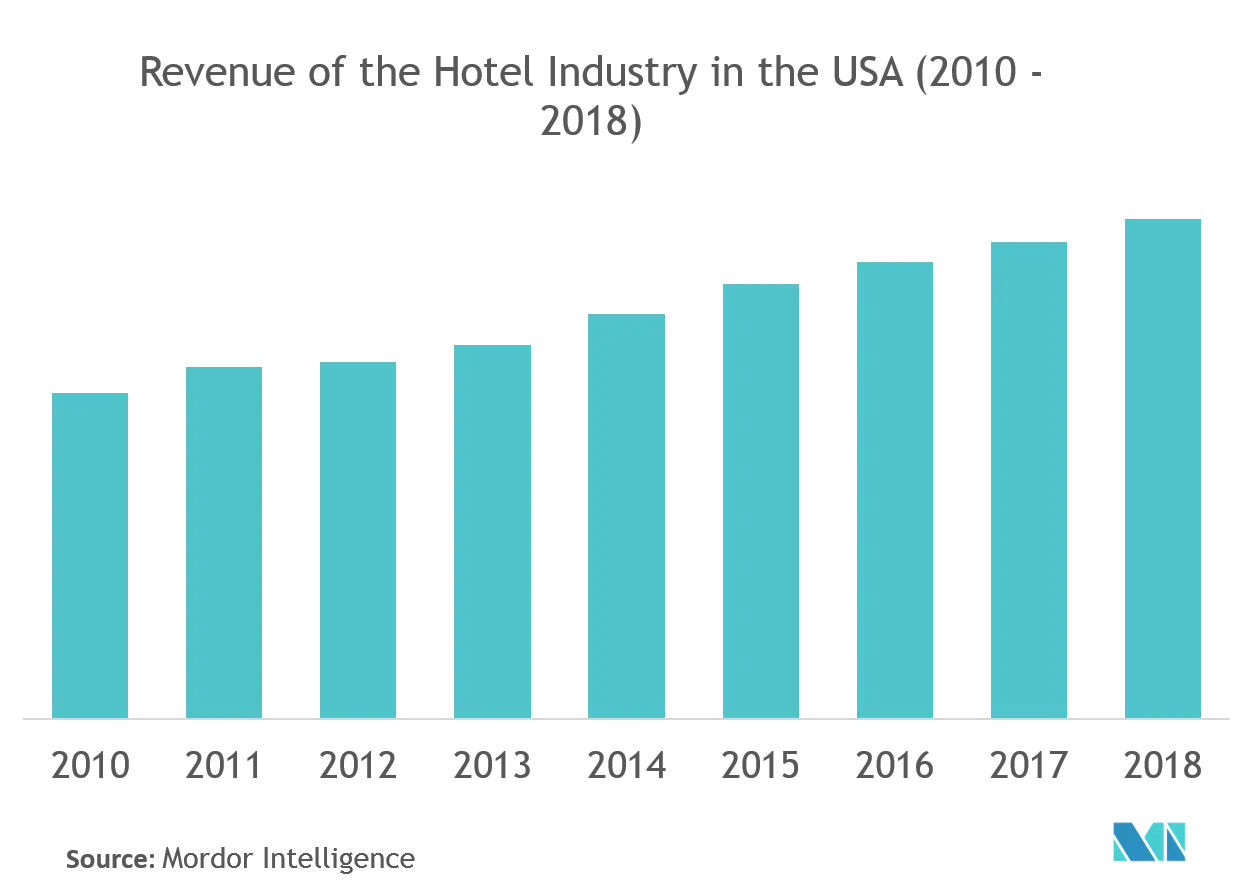
Airbnb has Changed the Face of the Hospitality Industry in the United States
When it entered the hospitality industry in the United States in 2008, Airbnb was barely known to the general public. Yet, with its innovative space sharing idea and digitalization technique, it attracted the younger generation and reached a break-even point after a year from its inception. Currently, more than 60% of the accounts in Airbnb belong to millennials. It succeeded in attracting a greater number of customers, through its pricing strategy. Airbnb is offering shared spaces at fairly cheaper rates in the leading cities of the United States and the United Kingdom. There are spaces available for USD 14 per night, even in the prime cities of the world. According to recent statistics, Airbnb has approximately 150 million users and covers more than 65,000 cities in the world, with more than 5 million listings.

United States Hospitality Industry Overview
The hospitality industry in the United States is dynamic. The region hosts a high number of brands with global footprints. Airbnb has been attracting a large consumer base and it recorded an increasing number of listings and bookings over the past few years. The entry of the concept of shared space has been giving a tough competition to the major players, over the past 3 to 4 years.
United States Hospitality Market Leaders
Marriott International
Hilton Worldwide
Wyndham Hotels & Resorts
InterContinental Hotels Group (IHG)
Choice Hotels International
*Disclaimer: Major Players sorted in no particular order

United States Hospitality Market Report - Table of Contents
1. INTRODUCTION
1.1 Study Deliverables
1.2 Scope of the Study
2. RESEARCH METHODOLOGY
3. EXECUTIVE SUMMARY
4. MARKET INSIGHTS AND DYNAMICS
4.1 Market Overview
4.2 Market Dynamics
4.2.1 Drivers
4.2.2 Restraints
4.2.3 Opportunities
4.3 Impact of COVID-19 on the Hospitality Industry
4.4 Insights on Revenue Flows from the Accommodation and Food and Beverage Sectors
4.5 Leading Cities in the United States, with Respect to the Number of Visitors
4.6 Investments (Real Estate, FDI, and Others) in the Hospitality Industry
4.7 Technological Innovations in the Hospitality Industry
4.8 Insights on the Impact of Shared Living Spaces on the Hospitality Industry
4.9 Insights on Other Economic Contributors to the Hospitality Industry
4.10 Value Chain Analysis
4.11 Porter's Five Forces Analysis
5. MARKET SEGMENTATION
5.1 By Type
5.1.1 Chain Hotels
5.1.2 Independent Hotels
5.2 By Segment
5.2.1 Service Apartments
5.2.2 Budget and Economy Hotels
5.2.3 Mid and Upper Mid-scale Hotels
5.2.4 Luxury Hotels
6. COMPETITVE INTELLIGENCE
6.1 Market Concentration
6.2 Company Profiles
6.2.1 Marriott International
6.2.2 Hilton Worldwide
6.2.3 Wyndham Hotels & Resorts
6.2.4 InterContinental Hotels Group (IHG)
6.2.5 Choice Hotels International
6.2.6 Best Western Hotels & Resorts
6.2.7 Hyatt Hotels Corporation
6.2.8 G6 Hospitality
6.2.9 Aimbridge Hospitality
6.2.10 Airbnb
- *List Not Exhaustive
6.3 Loyalty Programs Offered by Major Hotel Brands
7. INVESTMENT ANALYSIS
8. FUTURE OUTLOOK OF THE INDUSTRY
9. APPENDIX
United States Hospitality Industry Segmentation
A complete background analysis of the hospitality industry in the United States, which includes an assessment of the industry associations, the overall economy and the emerging market trends based on segments, significant changes in the market dynamics, and the market overview, is covered in the report.
United States Hospitality Market Research FAQs
What is the current us hospitality market size.
The US Hospitality Market is projected to register a CAGR of 5.5% during the forecast period (2024-2029)
Who are the key players in US Hospitality Market?
Marriott International, Hilton Worldwide, Wyndham Hotels & Resorts, InterContinental Hotels Group (IHG) and Choice Hotels International are the major companies operating in the US Hospitality Market.
What years does this US Hospitality Market cover?
The report covers the US Hospitality Market historical market size for years: 2019, 2020, 2021, 2022 and 2023. The report also forecasts the US Hospitality Market size for years: 2024, 2025, 2026, 2027, 2028 and 2029.
Our Best Selling Reports
- Artificial Intelligence in Healthcare Market
- Global Patient Registry Software Market
- Thailand Energy Market
- Thermal Energy Storage Market
- Fitness Tracker Market
- Global Computerized Physician Order Entry (CPOE) Systems Market
- Operating Room Equipment Market
- Global Immunohistochemistry Market
- Facial Recognition Market
- Smart Waste Management Market
US Hospitality Industry Report
Statistics for the 2024 US Hospitality market share, size and revenue growth rate, created by Mordor Intelligence™ Industry Reports. US Hospitality analysis includes a market forecast outlook to 2029 and historical overview. Get a sample of this industry analysis as a free report PDF download.
US Hospitality Market Report Snapshots
- US Hospitality Market Size
- US Hospitality Market Share
- US Hospitality Market Trends
- US Hospitality Companies
- US Hospitality News
Please enter a valid email id!
Please enter a valid message!

US Hospitality Market Get a free sample of this report
Please enter your name
Business Email
Please enter a valid email
Please enter your phone number
Get this Data in a Free Sample of the US Hospitality Market Report
Please enter your requirement

Thank you for choosing us for your research needs! A confirmation has been sent to your email. Rest assured, your report will be delivered to your inbox within the next 72 hours. A member of our dedicated Client Success Team will proactively reach out to guide and assist you. We appreciate your trust and are committed to delivering precise and valuable research insights.
Please be sure to check your spam folder too.
Sorry! Payment Failed. Please check with your bank for further details.
Add Citation APA MLA Chicago
➜ Embed Code X
Get Embed Code
Want to use this image? X
Please copy & paste this embed code onto your site:
Images must be attributed to Mordor Intelligence. Learn more
About The Embed Code X
Mordor Intelligence's images may only be used with attribution back to Mordor Intelligence. Using the Mordor Intelligence's embed code renders the image with an attribution line that satisfies this requirement.
In addition, by using the embed code, you reduce the load on your web server, because the image will be hosted on the same worldwide content delivery network Mordor Intelligence uses instead of your web server.
More From Forbes
The travel and tourism industry by 2030.
- Share to Facebook
- Share to Twitter
- Share to Linkedin
Oscar White is the Founder & CEO of Beyonk , the experiences booking platform: empowering events, activities & experience providers to thrive
The ever-increasing speed of technological advancements and changing consumer expectations makes it arguably more difficult to forecast the future of the tourism industry than ever before. However, looking at macro-trends, there is a clear direction of travel that could substantially change the industry as we know it. The trends favor the end consumers and organizations that, paraphrasing Darwin, are “most adaptable to change.” They will be more likely to survive and thrive. As an ex-strategy consultant and public speaker on digital and technology trends, and now running venture-backed, travel-tech startup Beyonk , here are my predictions for the state of the industry by 2030.
1. Customers will become empowered through more choice and control.
As the tech giants lead the way in designing products that provide the best customer experience, from Amazon with single-click buying of every sort of product to Uber with quick and simple pickups, our expectations continue to evolve. Customers will want more, in less time and with less effort. Millions of bookings, analyzed by Beyonk, show 65% of consumers book within 48 hours of their events and activities. This will likely shorten as the friction of finding and booking in-destination experiences reduces.
2. Connectivity will become commoditized.
Since 2006, the travel industry has benefited from the General Transit Feed Specification, a standard for how data is accessible across industry stakeholders. While it’s unlikely that the rest of the tourism industry will get a similar standard, connectivity will continue to grow between suppliers, resellers and customers. This is a natural evolution of the tourism industry and will likely continue to make consumers more powerful with their decision-making and as a whole, make it easier to find and book with long-tail providers or book multiple categories at once. A series of application programmable interfaces could give access to a large portion of the supply. Many online travel agents could then access similar supply, making branding, differentiation and customer experience even more important to compete.
3. Personalization will become more important.
With the explosion of available data, services that are able to meaningfully present the relevant data in a constructive way will probably thrive. The more companies can tailor their offering to suit personal preferences, the more they’ll win. From the pre-sales aspect, they’ll be able to target suitable audiences with a compelling offer and lead them into personalized customer journeys — from building itineraries to selecting the room package and flight.
Best Travel Insurance Companies
Best covid-19 travel insurance plans.
The challenge of Apple and Google changing their privacy policies and ability to use third-party cookies has made it more difficult to personalize offers, ads and communications to relevant audiences. Companies are investing more to build up more first-person data such as emails. But they are struggling too, as Apple has introduced masking and obfuscation of email addresses, including in-browser privacy protection, which masks users’ IP addresses. An opportunity for personalization may come through Web 3.0 — where each person could have a single profile that follows you across the internet, that can be shared to allow websites to show you content specific to your profile to give you the best browsing experience and allow you to control the data you share. Those who are able to keep responding to the ever-changing privacy changes, but still build out strong personalization strategies, will build more loyal customer bases, have more efficient spending and reduce the cost of acquiring new customers.
4. Online channels will become seamless with offline channels.
As augmented and virtual reality technology improves, the price point for such devices in this space will drop significantly. AR and VR will become the new way to experience destinations, travel and things to do. For the initial pre-buying process, there will be a more immersive experience, moving closer to a “try before you buy” approach, as witnessed in retail over the last decade, with more brands adopting such features. See my article, “Ecommerce Trends for the Tourism and Travel Industry,” for a more in-depth discussion of this.
It is clear we are moving toward in-destination experiences where you can have an overlay of reviews for each menu item, or have a virtual tour guide giving you tips wherever you are via your wearable device. We, as both consumers and providers, will become more equipped with data to have better experiences. Those organizations that can cater to a more seamless online and offline experience could win big.
While it’s impossible to predict the future, the trends suggest the future of the industry could be grounded in further maturity of timely, relevant data and making it consumable across channels to delight customers.
Forbes Business Council is the foremost growth and networking organization for business owners and leaders. Do I qualify?

- Editorial Standards
- Reprints & Permissions

Online MS in Hospitality & Tourism
Hospitality and tourism industry prepares for post-pandemic rebound.

Before COVID-19 turned the world upside down, the hospitality and tourism industry was responsible for more than 10 percent of global GDP and one in every 10 jobs worldwide, according to the World Travel & Tourism Council (WTTC). It was also one of the fastest-growing fields, accounting for one in four new jobs created over the previous five years.
The pandemic changed all that, at least temporarily. While few segments of the economy were spared, hospitality and tourism were particularly hard hit. The WTTC reported that the sector lost $4.5 trillion in 2020, with its contribution to GDP plummeting 49.1 percent, compared with just a 3.7 percent decline in the overall global economy.
While COVID-19 has caused significant disruption, the hospitality and tourism industry is resilient and is coming back stronger following previous downturns, such as those caused by the 9/11 terrorist attacks and the 2008 economic crash, according to Dr. Hicham Jaddoud , who teaches Global Hospitality and Tourism in the USC Bovard College’s Online Master of Science in Hospitality and Tourism program.
“Growth in the sector has become greater after each crisis,” he says. “Why? Because hospitality takes advantage of that slow time to retrain, refresh and develop new concepts that are even more appealing to consumers.”
In spite of the recent tumult—and in many ways because of it—Jaddoud and other experts say the industry is now accelerating some of its longstanding priorities in the areas of sustainability, efficiency, innovation and technology.
Renewed Focus on Renewables
The Environmental Protection Agency estimates an average of 63 million tons of food waste per year in the United States alone, with some 40 percent of that accounted for by hotels and other consumer-facing businesses, according to the American Hotel and Lodging Association. Meanwhile, daily water usage per occupied hotel room averages 100 to 400 gallons.
While many hospitality organizations were introducing more sustainable practices pre-pandemic, in reality it remained challenging for large parts of the sector.
“The industry was moving at such a quick pace,” says Diana C. Beltran , a hospitality management executive who teaches Managing Service Quality in Hospitality and Tourism at USC Bovard. “Tourism was growing exponentially every year. There was just no time to focus on reducing energy consumption, for instance. We should have always been operating smartly and efficiently yet many in the industry were just operating as fast as they could with the priority of making sales. There was no incentive nor time to operate efficiently. Now we really have to buckle our belts and cut costs since the sales are no longer there and there is more time to look at details in the operation.”
“Weaker players are exiting the marketplace or are being absorbed by stronger players,” Leonard Jackson , a specialist in business development and financial management who teaches at USC Bovard, adds. “Some companies are using available government funding to retool, renovate and get their properties ready to come back once this pandemic is over. In a sense, the industry is righting itself.”
This includes upgrades to laundry facilities, showers and toilets in individual rooms, and other methods to reduce water consumption.
Beltran agrees. “Renovations are taking place left and right,” she says. “Facilities that have been closed are taking the time to renovate and become more efficient.”
The industry is fully embracing corporate social responsibility initiatives, says Jackson. “New buildings are incorporating sustainable practices,” he says. “That was becoming the norm, even prior to COVID, but it will increase. This is all consumer-driven. Consumers generally want to stay and host their events at green facilities.”
“Now there’s the opportunity for tourism and hospitality brands to evolve and become more conscientious to attract people who understand why they need to pay extra for a specific initiative that’s sustainable and more mindful of long-term impact,” notes Anna Abelson , a destination marketing expert who teaches Marketing Strategies for Hospitality and Tourism at USC Bovard.
“Guests know what they want from a business, which is to be sustainably and environmentally responsible, and they only support businesses that go that route,” Jaddoud adds. “That goes for minimizing food waste, consumption of water, use of soap and chemicals, and choosing local produce and supplies.”
The Challenge of Disposables
The industry had been retreating from single-use plastics—including flatware and straws—to meet both consumer demand and increased restrictions on such products in environmentally conscious locales. But with the advent of COVID-19, companies returned to disposables for safety reasons and to boost confidence among consumers.
“Single-use utensils are something you want to get away from if you want to protect the climate, but it’s something we have to have right now,” Abelson notes.
“When companies go back to normal flatware, there will be an additional cost,” Jaddoud adds. “Now flatware has to be cleaned in very specific temperatures, using specific chemicals and processes. But at the end of the day, it’s safety that counts.”
He observes that such corporate decision-making revolves around market specifics as well as venue type. For example, he says a steakhouse or other upscale restaurant will avoid disposables whereas in a grab-and-go setting, consumers find them acceptable.
Beltran, however, says she is seeing more travelers willing to pack their own utensils and straws, as well as coffee mugs and water bottles. “The culture of the consumer is changing,” she says. “In addition to being more conscientious about bacteria, germs and viruses, they also want to reduce waste. It’s still going to take some time before we all get there. But it’s changing on both ends—the consumer and the industry.”
This move toward more sustainable practices will only increase, experts predict.
“Changes to operational practices that consumers were asking for during COVID are going to become the norm,” says Jackson. For instance, many restaurants have eliminated printed menus entirely, using QR codes scanned by customers to electronically access menu options. More patrons have opted to forgo hotel room cleaning. “If these trends continue, hotels and restaurants will benefit from an operational standpoint, while reducing their carbon footprint,” he says.
High-Tech vs. High-Touch
Meanwhile, certain trends already underway have sped up. For example, the pandemic expedited the industry’s move to contactless interactions—from hotel check-in to food ordering to booking and boarding flights, Jaddoud notes.
“COVID is reorganizing our industry, and we’re going to emerge stronger, leaner and more technologically savvy,” Jackson adds.
Yet that doesn’t mean the field will lose its human aspect. “Hospitality will always be a human interaction-driven industry but the pandemic has changed the preferences and tastes of the consumer,” Jaddoud says.
“Technology will be important, but hospitality brands should certainly keep that high-touch focus at the forefront, because technology is just one side of the coin,” Abelson agrees. “To build loyalty with customers, you need to make sure that you understand and customize their experience based on their needs and preferences so you really create that meaningful relationship for years to come.”
Retraining the Hospitality Workforce
Personnel must also keep pace with these changes. The WTTC notes that 68 percent of the travel and tourism workforce require some re-skilling in light of innovations occurring throughout the industry. Hospitality companies are also amping up efforts to attract and retain a more diverse talent pool.
The sector is training staff to implement contactless service and heightened hygiene measures, from sophisticated room cleaning approaches to and other protocols that build consumer confidence while protecting customer and employee safety. At many locations, employees will need to be taught how to take guests’ temperatures or how to manage visitors who refuse to comply with health-related policies. Other venues are introducing robots and other advanced technology to aid in the disinfecting process, and staff need to be educated on those efforts as well as encouraged to suggest new innovations.
“Hospitality is becoming more of a career path and not just a paycheck,” Jaddoud says. “This shift has happened in just the last few years—from both the employee and employer standpoint. It has made the hospitality industry better because when you have higher retention, you have more engagement and loyalty from the guests—and reduced training and turnover costs.”
Tourism and hospitality degree programs have seen a surge in applications as a result.
“New job profiles are emerging,” Beltran notes. “These include new positions that merge safety, quality and sustainability.”
The result will be more opportunity.
“I believe it’s the perfect time to be studying the hospitality environment,” Jaddoud says. “When companies come back, they’re going to be looking for more educated, critically thinking employees who are able to drive the industry forward.”
Students in the USC Bovard MS program come from a wide range of sectors within hospitality and tourism, including food and beverage, hotels, government tourism authorities, airlines, cruises, resorts and casinos. “It adds a lot of value,” Jaddoud says of the breadth of backgrounds represented. “Skills are transferable between all segments of hospitality and tourism.”
“Our industry is multifaceted. Students also learn from each other because everybody brings a different perspective,” says Abelson, who adds that students also vary in terms of their expertise and current roles within the industry. “Some have significant experience but want validation or to fine-tune their skills, and some are learning from the ground up,” she notes. “They’re a very impressive group of people who learn and apply the skills or knowledge right away.”
Learn more about the MS in Hospitality & Tourism program .
Request more information

The future of career advancement in the hospitality industry: trends and predictions
Catherine Schwartz

According to the World Travel & Tourism Council , before the pandemic, the hospitality industry accounted for about 1 in 4 jobs created worldwide, 10.3% of all jobs, and 10.3% of global GDP.
However, despite its vital role, career advancement in the hospitality industry has posed a significant challenge to many professionals. The long-standing traditional job hierarchies and a lack of clear career paths have left many in the dark, hindering their ability to reach their full potential.
As the hospitality industry continues to develop further and adapt to changing consumer demands and technological advancements, it’s vital to explore what the future of hospitality holds regarding career advancements.
This article will explore the emerging trends and predictions for the hospitality industry and provide professionals with practical strategies for navigating the industry’s dynamic landscape.
The current state of career advancement in the hospitality industry
Career advancement in the hospitality industry is challenging for many. Even with the magnitude of the industry and its significance, many professionals have encountered challenges in advancing their careers due to the traditional job hierarchy and the constrained capacity for growth.
The traditional career ladder is somewhat straightforward at the lower levels of the industry, such as housekeeping, front desk, and food services. Individuals at this level typically start their employment in an entry-level position and work up to supervisory roles and, eventually, management positions.
But beyond this point, it’s a different story entirely. The career path is much less lucid, and growth opportunities can be limited.
A significant part of the problem may be attributed to the fact that many hospitality organizations have a rigid job hierarchy that discourages lateral moves or career changes. And this can leave individuals feeling stuck and out of place in their current roles, with little to no room for advancement.
The COVID-19 pandemic also contributed to its quota, as it caused massive disruptions in the industry, leading to massive layoffs and reduced opportunities for expansion and growth. Many individuals with big dreams have been forced to put their aspirations on hold or switch to new industries altogether.
However, despite all of these obstacles, there have also been a few promising advancements over time. For example, the industry is beginning to attach more importance to employee development. It is now investing in programs that provide staff with the necessary skills to advance in their careers.
Richard Mace, CEO at Malvern House , adds, “There is also more emphasis on mentorship in the hospitality industry, with experienced professionals actively guiding and supporting the development of younger colleagues.”
Emerging trends in the hospitality industry
As the hospitality sector emerges as a highly fluid industry, it is increasingly important to remain up-to-date with the latest developments that could influence professional growth.
One of the most noteworthy developments in the sector is the increasing effect of technological progress. With the surge of online travel agencies, mobile reservation platforms, and other digital solutions, how customers engage with the sector has acquired a new aspect.
Consequently, professionals in the sector need to have a robust comprehension of the influence of technology and its implications for maintaining competitiveness.
Also, with the growing number of international travelers, language skills have become increasingly important. Learning a new language can help professionals provide exceptional customer service and enhance their career prospects.
A further up-and-coming development within the hospitality industry is the amplified significance of sustainability . A growing number of customers are presently giving more significant consideration to how their activities affect the environment. Consequently, there is a swiftly expanding requirement for ecologically responsible resolutions in the industry.
Consequently, hospitality professionals who can proficiently execute eco-friendly practices will experience a surge in demand, thereby initiating a fresh wave of career advancement opportunities.
Alterations in consumer preferences and expectations are further influencing career progression within the hospitality industry. Numerous customers demand more personalized experiences , leading to an escalating desire for professionals with exceptional communication and social skills.
Professionals who show exceptional ability to connect with guests and provide top-notch customer service will be highly valued in the industry.
Finally, the COVID-19 pandemic has also accelerated specific trends in the hospitality industry, including a growing demand for contactless technology and hygiene practices. As this transforms into the norm in the industry, specialists who possess expertise in these areas will be better situated for career advancement.
By keeping up-to-date with emerging patterns in the hospitality industry, professionals can ensure they stay on the right path to success in the constantly fluctuating hospitality industry.
Predictions for the future of career advancement in the hospitality industry
So, what exactly will the future of career advancement in the hospitality industry look like? Here are a few predictions for the future of hospitality careers.
• Use of Automation and Artificial Intelligence : With the introduction of self-help kiosks and chatbots, it is probable that numerous regular tasks will become automated , enabling personnel to concentrate on more demanding and value-enhancing duties.
According to Catherine Schwartz, Finance Editor at Crediful , “Despite the potential elimination of some positions, this shift will also generate fresh opportunities for experts who possess the skill to operate and exploit this novel yet extremely sophisticated technologies.”
• Increased demand for soft skills : Soft skills such as emotional intelligence, resilience, adaptability, and creativity will likely be more critical in the hospitality industry. As more and more routine tasks are automated, the personal touch will become even more essential to creating an exceptional guest experience. Professionals who can effectively communicate, solve problems, and be team players will be highly valued in the industry.
• Creation of new job roles : The traditional career progression in the hospitality sector is expected to transform, resulting in fresh employment positions and career paths. For example, the rise of home-sharing platforms like Airbnb has led to the growth and spread of vacation rental management companies, thus, creating new opportunities for professionals who can manage and market properties.
Various trends will likely shape the future of career advancement in the hospitality industry. By staying up to date with all the trends and developing the necessary skills and knowledge, professionals in the industry can set themselves up for success in the coming years.
Strategies for advancing in the hospitality industry
When it comes to advancing in the hospitality industry and achieving desired goals, there are proven strategies that individuals can take advantage of to reach their full potential.
• Networking and Mentorship : These are essential strategies for career advancement in almost every industry. Professionals should always look for opportunities to meet and connect with others in the industry.
Janelle Owens, Human Resource Director at Test Prep Insight , states, “Attending conferences and industry events and participating in online forums and social media groups is a great idea. This can help build positive relationships that may lead to potential job opportunities or career advancement.”
In addition, mentorship can be a precious tool for career development. Seeking guidance from experienced professionals in the industry never hurts, and it will only help to navigate career challenges and provide valuable insights and advice.
• Education and Upskilling : As the industry continues to evolve, professionals must stay up to date with the latest practices so that they are not left behind. Putting in the extra effort to expand your language skills by learning Koine Greek for example, and getting more education or certifications can help professionals stand out in an already saturated job market and provide opportunities for career advancement.
Upskilling or acquiring new skills relevant to emerging trends is also very beneficial. For example, acquiring knowledge about sustainability practices, data analysis, or customer experience design can give professionals a competitive edge and open new career paths.
• Taking on new challenges : Being proactive and taking on new challenges is another fundamental strategy for career advancement in hospitality. Rather than lying around and waiting for opportunities to come to them, professionals should actively seek out new responsibilities and projects that will help them develop their skills.
One option is to take on leadership roles, spearhead new initiatives, and look out for new and creative solutions to problems. This can demonstrate value and potential to employers and position individuals for career growth.
As the hospitality industry continues to evolve, so will career advancement opportunities. Even though challenges and barriers to career advancement in the industry exist, emerging trends and predictions suggest that the future of career advancement is bright.
Technological advancements, changes in consumer preferences and needs, and sustainability concerns are driving massive changes in the industry, leading to new job roles and career advancement opportunities. However, it is more apparent than ever that professionals will need to up their game, adapt and upskill continuously to thrive.
Undoubtedly, the future of career advancement in the hospitality industry is promising. Professionals who continue to develop their skills and competencies will be In a pole position to succeed in this fascinating and dynamic sector.

Related Articles

Navigating challenges of AI and maximizing value in the service sector

The future of hotel safety: Integrating advanced security solutions

Digital disruption: how hotels are embracing change

UNWTO Ministers Summit in London: Transforming tourism through education and youth empowerment
Related courses.
You might also like:

Green check-in: strategies for hotels to adopt and promote sustainability

Imagine a day in the life of a Revenue Manager….without using acronyms

Booking insights reveal the top 10 places most likely to have already booked their 2025 holiday

Forbes Travel Guide ratings opinion on the new relevance of luxury

Join over 60,000 industry leaders.
Receive daily leadership insights and stay ahead of the competition.
Leading solution providers:

FCS Solutions

Sabre Corporation

The magazine of Glion Institute of Higher Education
- What is tourism and hospitality?

Tourism and hospitality are thriving industries encompassing many sectors, including hotels, restaurants, travel, events, and entertainment.
It’s an exciting and dynamic area, constantly evolving and adapting to changing customer demands and trends.
The tourism and hospitality industry offers a diverse range of career opportunities that cater to various interests, skills, and qualifications, with positions available from entry-level to executive management.
The booming tourism and hospitality industry also offers job security and career growth potential in many hospitality-related occupations.
What is tourism?
Tourism is traveling for leisure, pleasure, or business purposes and visiting various destinations, such as cities, countries, natural attractions, historical sites, and cultural events, to experience new cultures, activities, and environments.
Tourism can take many forms, including domestic, or traveling within your country, and international tourism, or visiting foreign countries.
It can also involve sightseeing, adventure tourism , eco-tourism, cultural tourism, and business tourism, and it’s a huge contributor to the global economy, generating jobs and income in many countries.
It involves many businesses, including airlines, hotels, restaurants, travel agencies, tour operators, and transportation companies.

What is hospitality?
Hospitality includes a range of businesses, such as hotels, restaurants, bars, resorts, cruise ships, theme parks, and other service-oriented businesses that provide accommodations, food, and beverages.
Hospitality is all about creating a welcoming and comfortable environment for guests and meeting their needs.
Quality hospitality means providing excellent customer service, anticipating guests’ needs, and ensuring comfort and satisfaction. The hospitality industry is essential to tourism as both industries often work closely together.
What is the difference between tourism and hospitality?
Hospitality and tourism are both related and separate industries. For instance, airline travel is considered as part of both the tourism and hospitality industries.
Hospitality is a component of the tourism industry, as it provides services and amenities to tourists. However, tourism is a broader industry encompassing various sectors, including transportation, accommodation, and attractions.
Transform your outlook for a successful career as a leader in hospitality management
This inspiring Bachelor’s in hospitality management gives you the knowledge, skills, and practical experience to take charge and run a business

Is tourism and hospitality a good career choice?
So, why work in hospitality and tourism? The tourism and hospitality industry is one of the fastest-growing industries in the world, providing a colossal number of job opportunities.
Between 2021 and 2031, employment in the hospitality and tourism industry is projected to expand faster than any other job sector, creating about 1.3 million new positions .
A tourism and hospitality career can be a highly rewarding choice for anyone who enjoys working with people, has a strong service-oriented mindset, and is looking for a dynamic and exciting career with growth potential.
Growth and job opportunities in tourism and hospitality
Tourism and hospitality offers significant growth and job opportunities worldwide. The industry’s increasing demand for personnel contributes to economic and employment growth, particularly in developing countries.
The industry employs millions globally, from entry-level to high-level management positions, including hotel managers, chefs, tour operators, travel agents, and executives.
It provides diverse opportunities with great career progression and skill development potential.
Career paths in tourism and hospitality

There are many career opportunities in tourism management and hospitality. With a degree in hospitality management, as well as relevant experience, you can pursue satisfying and fulfilling hospitality and tourism careers in these fields.
Hotel manager
Hotel managers oversee hotel operations. They manage staff, supervise customer service, and ensure the facility runs smoothly.
Tour manager
Tour managers organize and lead group tours. They work for tour companies, travel agencies, or independently. Tour managers coordinate a group’s transportation, accommodations, and activities, ensuring the trip runs to schedule.
Restaurant manager
Restaurant managers supervise the daily operations of a restaurant. They manage staff, ensure the kitchen runs smoothly, and monitor customer service.
Resort manager
Resort managers supervise and manage the operations of a resort. From managing staff to overseeing customer service, they ensure the entire operation delivers excellence.
Entertainment manager
Entertainment managers organize and oversee entertainment at venues like hotels or resorts. They book performers, oversee sound and lighting, and ensure guests have a great experience.
Event planner
Event planners organize and coordinate events, such as weddings, conferences, and trade shows. They work for event planning companies, hotels, or independently.
vent planners coordinate all aspects of the event, from the venue to catering and decor.
Travel consultant
Travel consultants help customers plan and book travel arrangements, such as flights, hotels, and rental cars. They work for travel agencies or independently. Travel consultants must know travel destinations and provide superb customer service.
What skills and qualifications are needed for a career in tourism and hospitality?

Tourism and hospitality are rewarding industries with growing job opportunities. Necessary qualifications include excellent skills in communication, customer service, leadership, problem-solving, and organization along with relevant education and training.
Essential skills for success in tourism and hospitality
A career in the tourism and hospitality industry requires a combination of soft and technical skills and relevant qualifications. Here are some of the essential key skills needed for a successful career.
- Communication skills : Effective communication is necessary for the tourism and hospitality industry in dealing with all kinds of people.
- Customer service : Providing excellent customer service is critical to the success of any tourism or hospitality business . This requires patience, empathy, and the ability to meet customers’ needs.
- Flexibility and adaptability : The industry is constantly changing, and employees must be able to adapt to new situations, be flexible with their work schedules, and handle unexpected events.
- Time management : Time management is crucial to ensure guest satisfaction and smooth operations.
- Cultural awareness : Understanding and respecting cultural differences is essential in the tourism and hospitality industry, as you’ll interact with people from different cultures.
- Teamwork : Working collaboratively with colleagues is essential, as employees must work together to ensure guests have a positive experience.
- Problem-solving : Inevitably, problems will arise, and employees must be able to identify, analyze, and resolve them efficiently.
- Technical skills : With the increasing use of technology, employees must possess the necessary technical skills to operate systems, such as booking software, point-of-sale systems, and social media platforms.
Revenue management : Revenue management skills are crucial in effectively managing pricing, inventory, and data analysis to maximize revenue and profitability
Master fundamental hospitality and tourism secrets for a high-flying career at a world-leading hospitality brand
With this Master’s degree, you’ll discover the skills to manage a world-class hospitality and tourism business.

Education and training opportunities in tourism and hospitality
Education and training are vital for a hospitality and tourism career. You can ensure you are prepared for a career in the industry with a Bachelor’s in hospitality management and Master’s in hospitality programs from Glion.
These programs provide a comprehensive understanding of the guest experience, including service delivery and business operations, while developing essential skills such as leadership, communication, and problem-solving. You’ll gain the knowledge and qualifications you need for a successful, dynamic, and rewarding hospitality and tourism career.
Preparing for a career in tourism and hospitality
To prepare for a career in tourism and hospitality management, you should focus on researching the industry and gaining relevant education and training, such as a hospitality degree . For instance, Glion’s programs emphasize guest experience and hospitality management, providing students with an outstanding education that launches them into leading industry roles.
It would help if you also worked on building your communication, customer service, and problem-solving skills while gaining practical experience through internships or part-time jobs in the industry. Meanwhile, attending industry events, job fairs, and conferences, staying up-to-date on industry trends, and networking to establish professional connections will also be extremely valuable.
Finding jobs in tourism and hospitality
To find jobs in tourism and hospitality, candidates can search online job boards, and company career pages, attend career fairs, network with industry professionals, and utilize the services of recruitment agencies. Hospitality and tourism graduates can also leverage valuable alumni networks and industry connections made during internships or industry projects.
Networking and building connections in the industry
Networking and building connections in the hospitality and tourism industry provide opportunities to learn about job openings, meet potential employers, and gain industry insights. It can also help you expand your knowledge and skills, build your personal brand, and establish yourself as a valuable industry professional.
You can start networking by attending industry events, joining professional organizations, connecting with professionals on social media, and through career services at Glion.
Tips for success in tourism and hospitality

Here are tips for career success in the tourism and hospitality industry.
- Gain relevant education and training : Pursue a hospitality or tourism management degree from Glion to gain fundamental knowledge and practical skills.
- Build your network : Attend industry events, connect with colleagues and professionals on LinkedIn, and join relevant associations to build your network and increase your exposure to potential job opportunities.
- Gain practical experience : Look for internships, part-time jobs, or volunteering opportunities to gain practical experience and develop relevant skills.
- Develop your soft skills : Work on essential interpersonal skills like communication, empathy, and problem-solving.
- Stay up-to-date with industry trends : Follow industry news and trends and proactively learn new skills and technologies relevant to tourism and hospitality.
- Be flexible and adaptable : The tourism and hospitality industry constantly evolves, so be open to change and to adapting to new situations and challenges.
- Strive for excellent guest service : Focus on delivering exceptional guest experiences as guest satisfaction is critical for success.
Tourism and hospitality offer many fantastic opportunities to create memorable guest experiences , work in diverse and multicultural environments, and develop transferable skills.
If you’re ready to embark on your career in tourism and hospitality, Glion has world-leading bachelor’s and master’s programs to set you up for success.
Photo credits Main image: Maskot/Maskot via Getty Images

LIVING WELL

HOSPITALITY UNCOVERED

BUSINESS OF LUXURY

LISTENING TO LEADERS

WELCOME TO GLION.
This site uses cookies. Some are used for statistical purposes and others are set up by third party services. By clicking ‘Accept all’, you accept the use of cookies
Privacy Overview
- Screen Reader
- Skip to main content
- Text Size A
- Language: English
Case Studies
- EXIM Procedure
Media & Events
- Image Gallery
- Media Coverage
Other Links
- GI of India
- Experience India
- Indian Trend Fair 2022
India Organic Biofach 2022
Gulfood dubai 2023, tourism and hospitality, tourism & hospitality industry in india, the tourism sector is projected to contribute us$ 250 billion to the country’s gdp by 2030, generating employment for 137 million individuals., advantage india, robust demand.
* Drawing upon world-class healthcare amenities and traditional healing practices, medical tourism and wellness retreats entice 21% of international travelers.
* The travel market in India is projected to reach US$ 125 billion by FY27 from an estimated US$ 75 billion in FY20.
* International tourist arrivals are expected to reach 30.5 million by 2028.
* According to WTTC, over the next decade, India’s Travel & Tourism’s GDP is expected to grow at an average of 7.1% annually.
Attractive Opportunities
* India is geographically diverse and offers a variety of cultures that come with its own experiences, making it one of the leading countries in terms of international tourism expenditure.
* Travel and tourism are two of the largest industries in India, with a total contribution of about US$ 199.6 billion to the country’s GDP.
* The government has taken steps to boost investments in facilitate spiritual tourism with states like Uttar Pradesh developing tourist circuits and Uttarakhand and West Bengal enhancing infrastructure for pilgrims.
Policy support
* In the 2024 interim Budget, Finance Minister Ms. Nirmala Sitharaman allocated Rs. 2,449.62 crore (US$ 294.8 million) to the tourism sector, a 44.7% increase from the previous fiscal year.
* The Ministry of Tourism launched the Swadesh Darshan Scheme to develop theme-based tourist circuits, sanctioning 76 projects. Upgraded to Swadesh Darshan 2.0 (SD2.0).
* The Prime Minister, Mr. Narendra Modi inaugurates and unveils 52 tourism sector projects valued at over Rs. 1,400 crore (US$ 168.5 million) under the Swadesh Darshan and PRASHAD Scheme.
Diverse Attractions
* Airport enhancement and the spread of regional airports are opening new opportunities for business, and for drawing larger visits from tourists.
* The country’s big coastline is dotted with attractive beaches.
Tourism and Hospitality Industry Report
Introduction.
With a total area of 3,287,263 sq. km extending from the snow-covered Himalayan heights to the tropical rain forests of the south, India has a rich cultural and historical heritage, variety in ecology, terrains and places of natural beauty spread across the country. This provides a significant opportunity to fully exploit the potential of the tourism sector.
India being one the most popular travel destinations across the globe has resulted in the Indian tourism and hospitality industry emerging as one of the key drivers of growth among the services sector in India. The tourism industry in India has significant potential considering that Tourism is an important source of foreign exchange in India similar to many other countries.
It is widely acknowledged that the tourist and hospitality sector, which encompasses travel and hospitality services like hotels and restaurants, is a development agent, a catalyst for socioeconomic growth, and a significant source of foreign exchange gains in many countries. India's rich and exquisite history, culture, and diversity are showcased through tourism while also providing significant economic benefits. The consistent efforts of the central and state governments have helped the tourism industry to recover from the COVID-19 pandemic shock and operate at the pre-pandemic level.

Market Size
According to WTTC, India is ranked 10th among 185 countries in terms of travel & tourism’s total contribution to GDP in 2019. According to WTTC, the contribution of India's travel and tourism sector to India's economy was worth Rs. 15.9 trillion (US$ 191.25 billion) in 2022.
According to WTTC, over the next decade, India’s Travel & Tourism GDP is expected to grow at an average of 7.8% annually. In 2020, the Indian tourism sector accounted for 39 million jobs, which was 8% of the total employment in the country.
In 2021, the travel & tourism industry’s contribution to the GDP was US$ 178 billion; this is expected to reach US$ 512 billion by 2028. By 2029, it is expected to account for about 53 million jobs. In India, the industry’s direct contribution to the GDP is expected to record an annual growth rate of 7-9% between 2019 and 2030.
The travel market in India is projected to reach US$ 125 billion by FY27 from an estimated US$ 75 billion in FY20. The Indian airline travel market was estimated at ~US$ 20 billion and is projected to double in size by FY27 due to improving airport infrastructure and growing access to passports. The Indian hotel market including domestic, inbound and outbound was estimated at ~US$ 32 billion in FY20 and is expected to reach ~US$ 52 billion by FY27, driven by the surging demand from travellers and sustained efforts of travel agents to boost the market.
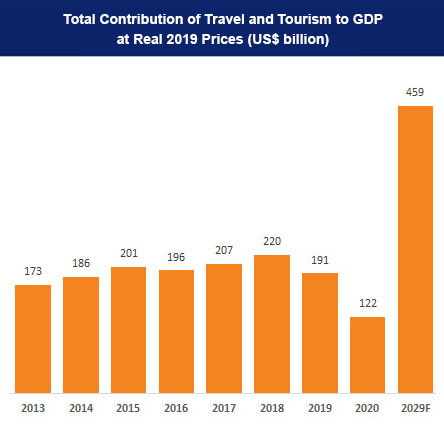
By 2028, international tourist arrivals are expected to reach 30.5 billion and generate revenue of over US$ 59 billion. However, domestic tourists are expected to drive the growth, post-pandemic. International hotel chains are increasing their presence in the country, and they will account for around 47% share of the tourism and hospitality sector of India by 2020 and 50% by 2022.
As per the Ministry of Tourism, Foreign Tourist Arrivals (FTAs) in October 2023 were 8,11,411. FTAs during the period January-October 2023 were 72,43,680 as compared to 46,55,160 in January-October 2022.
The percentage share of Foreign Tourist Arrivals in India during October 2023 among the top 5 ports was highest at Delhi Airport (34.74%) followed by Mumbai Airport (14.75%), Haridaspur Land Check Post (9.03%), Chennai Airport (7.05%), Bengaluru Airport (5.71%). FTAs during the period January-September 2023 were 6.43 million.
The percentage share of Foreign Tourist Arrivals in India during October 2023 among the top 5 source countries was highest from Bangladesh (21.41%), followed by USA (15.65%), UK (11.27%), Australia (4.38%) and Canada (3.81%).
In 2023-24* (January-October), 24.97% of foreign tourists visited for Indian Diaspora which marks 72,43,680 foreigners.
FEE during the period January-October 2023 were US$ 22.32 billion.
Domestic visitor spending increased by 20.4% in 2022, only 14.1% below 2019. International visitor spending rose by 81.9% in 2022, but still 40.4% behind 2019 numbers.
Cumulative FDI equity inflow in the Hotel and Tourism industry is US$ 17.29 billion during the period April 2000-September 2023. This constitutes 2.60% of the total FDI inflow received across sectors.
Investments/Developments
- In December 2023, IHCL expanded its presence in Maharashtra as it signed a hotel in Bandra, Mumbai. The Brownfield project will be branded an IHCL- SeleQtions hotel.
- In December 2023, TAJ won the ‘World’s finest luxury grand palaces’ award at the ‘101 Best Executive Summit’ in Germany.
- In November 2023, Indian Hotels Company (IHCL) announced the opening of Ginger Mumbai, Airport. The 371 Keys flagship Ginger hotel, strategically located near the domestic airport will introduce the brand’s lean luxe design and service philosophy of offering a vibrant, contemporary, and seamless hospitality experience to its guests.
- In September 2023, Mahindra Holidays & Resorts (MHRIL) signed an MOU with the Government of Uttarakhand (UK) to invest Rs. 1,000 crore (US$ 120.16 million) and build 4-5 large marquee resorts over the next few years in Uttarakhand.
- An investment of Rs. 2,400 crore (US$ 289.89 million) was allocated to the Ministry of Tourism as the sector holds huge opportunities for jobs and entrepreneurship for youth.
- An investment-linked deduction under Section 35 AD of the Income Tax Act is in place for establishing new hotels under the 2-star category and above across India, thus permitting a 100% deduction in respect of the whole or any expenditure of capital nature.
- In 2019, the Government reduced GST on hotel rooms with tariffs of Rs. 1,001 (US$ 14.32) to Rs. 7,500 (US$ 107.31) per night to 12% and those above Rs. 7,501 (US$ 107.32) to 18% to increase India’s competitiveness as a tourism destination.
- In Union Budget 2023-24, US$ 290.64 million was allocated to the Ministry of Tourism as the sector holds huge opportunities for jobs and entrepreneurship for youth in particular and to take the promotion of tourism on mission mode, with the active participation of states, the convergence of government programmes and public-private partnerships.
- An app will be developed covering all relevant aspects of tourism. States will be encouraged to set up Unity Malls in State Capital as the most prominent tourism centres to promote One District One Product, GI products, handicrafts and products of other States.
- In 2021, Government of India announced 40,000 e-tourist visas out of 500,000 free regular visas to the tourist, to ensure a geographical spread of the incentive to important source markets globally.
- Government of India has set a target to create 220 new airports by 2025.
- The Emergency Credit Line Guarantee Scheme (ECLGS) covered through a liberal definition of MSME (micro small and medium enterprises) has been expanded to include tourism and hospitality stakeholders. Infrastructure status has been granted to exhibition-cum-convention centres.
- A separate liquidity window of Rs. 15,000 crore (US$ 1.8 billion) has been released for the sector.
- A total of 48,775 accommodation units (both classified and unclassified) have been registered on the National Integrated Database of Hospitality Industry (NIDHI) portal and 11,220 units have self-certified for SAATHI standards in September 2022.
- In October 2022, Indian Hotels Company (IHCL) announced the launch of its new Indian-concept restaurant brand, Loya. Debuting at Taj Palace, New Delhi, Loya captures the culinary essence traversing the landscape of North India.
- Hospitality unicorn OYO has acquired Europe-based vacation rental company Direct Booker for US$ 5.5 million in May 2022.
- Accor, a French hospitality major will expand its India's portfolio by adding nine additional hotels in the mid-scale and economy categories, bringing the total number of hotels 54 in India.
- The Medical Tourism sector is expected to increase at a CAGR of 21.1% from 2020-2027.
- India was globally the third largest in terms of investment in travel and tourism with an inflow of US$ 45.7 billion in 2018, accounting for 5.9% of the total investment in the country.
- Indian government has estimated that India would emerge with a market size of 1.2 million cruise visitors by 2030-31. Dream Hotel Group plans to invest around US$300 million in the next 3-5 years for the development of the cruise sector in India.
- India is the most digitally advanced traveller nation in terms of digital tools being used for planning, booking, and experiencing a journey. India’s rising middle class and increasing disposable income has supported the growth of domestic and outbound tourism.
- The United Nations World Tourism Organisation selected Pochampally in Telangana as one of the best tourism villages in November 2021.
Government Initiatives
The Indian Government has realised the country’s potential in the tourism industry and has taken several steps to make India a global tourism hub. Some of the major initiatives planned by the Government of India to boost the tourism and hospitality sector of India are as follows:
In the Union Budget 2023-24, US$ 290.4 million has been allocated to the Ministry of Tourism. Under the Union Budget 2023-24, an outlay of US$ 170.85 million has been allocated for the Swadesh Darshan Scheme to develop a complete package of 50 tourist destinations for providing a wholesome tourism experience by facilitating physical, digital and virtual connectivity, availability of tourist guides and tourist security.
Ministry of Tourism has sanctioned 76 projects under the scheme since its inception under 13 themes for a revised sanctioned cost of US$ 668.95 million and has released US$ 534.9 million (till December 31, 2021).
Under Budget 2023-24, the Government has allocated US$ 30.25 million for the development of tourist circuits under PRASHAD. Since its launch in January 2015 and Ministry has sanctioned 37 projects in 24 states with estimated expenditure of US$ 146.4 million and a cumulative amount of US$ 91.6 million has been released for these projects. 68 destinations/sites have been identified in 30 States/UTs for development under the PRASHAD Scheme as on March 31, 2022.
Ministry of Tourism has partnered with the Quality Council of India (QCI), to assist the Hospitality Industry in their preparedness to continue operations safely and mitigate risks arising out of the COVID-19 pandemic through an initiative called SAATHI (System for Assessment, Awareness and Training for Hospitality Industry). A hotel/unit goes through the SAATHI framework and agrees to fully follow the requirements wherever applicable possible, and a self-certification is issued. Self-certified Hotel/units attend webinars to clarify doubts through live interactions. If Hotel/unit desires, they may undertake site-assessment based on SAATHI framework through QCI accredited agencies and an assessment report with opportunities for improvement is shared with the assessed unit.
Under this Loan Guarantee Scheme for Covid Affected Tourism Service Sector (LGSCATSS), loan upto US$ 12,110 will be extended to each Tour Operators/ Travel Agents/ Tourist Transport Operators approved/recognized by the Ministry of Tourism.
Guarantees for Skill Development Loans by the member banks of IBA up to Rs. 1.5 lakh (US$ 1,801) extended by lending institutions to eligible borrowers without collateral or third-party guarantee.
- Visa reforms include a significantly expanded Golden Visa scheme, a five-year Green residency and new entry permits, including one for job seekers. The new system also offers additional benefits to sponsor family members
- To ease travels for international tourists, the Government of India has launched a scheme wherein five lakh tourists will get free visas.
- In August 2022, Ministry of Tourism sanctioned 76 projects for Rs. 5,399.15 crore (US$ 678.39 million) under Swadesh Darshan Scheme for development of tourism infrastructure in the country.
- In June 2022, the Ministry of Tourism along with Associations of Indian Universities (AIU) initiated a 12 episode webinar series under ‘Azadi Ka Amrut Mahotsav’ (AKAM) to engage and expose young minds of our country to the rich and diverse heritage of the country.
- Till the end of September 2022, a total of 155 Dekho Apna Desh webinars have been organized by Ministry of Tourism.
- The Ministry of Tourism has launched the National Strategy for Sustainable Tourism and Responsible Traveller Campaign in June 2022.
- From November 15, 2021, India allowed fully vaccinated foreign tourists to visit India, which in turn will help revive the Indian travel and hospitality sector.
- In November 2021, the Ministry of Tourism signed a Memorandum of Understanding (MoU) with Indian Railway Catering and Tourism Corporation to strengthen hospitality and tourism industry. The ministry has also signed a MoU with Easy My Trip, Cleartrip, Yatra.com, Make My Trip and Goibibo.
- In November 2021, the Indian government planned a conference to boost film tourism in the country with an aim to establish domestic spots as preferred filming destinations. This move is expected to create jobs and boost tourism in the country.
- In September 2021, the government launched NIDHI 2.0 (National Integrated Database of Hospitality Industry) scheme which will maintain a database of hospitality sector components such as accommodation units, travel agents, tour operators, & others. NIDHI 2.0 will facilitate the digitalisation of the tourism sector by encouraging all hotels to register themselves on the platform.
- Government is planning to boost the tourism in India by leveraging on the lighthouses in the country. 71 lighthouses have been identified for development as tourist spots.
- The Ministry of Road Transport and Highways has introduced a new scheme called ‘All India Tourist Vehicles Authorisation and Permit Rules, 2021’, in which a tourist vehicle operator can register online for All India Tourist Authorisation/Permit. This permit will be issued within 30 days of submitting the application.
- The Indian Railway Catering and Tourism Corporation (IRCTC) runs a series of Bharat Darshan tourist trains aimed at taking people to various pilgrimages across the country.
- During 2019-20, an additional fund Rs. 1,854.67 crore (US$ 269.22 million) was sanctioned for new projects under the Swadesh Darshan scheme.
- Ministry of Tourism sanctioned 18 projects covering all the North Eastern States for Rs. 1,456 crore (US$ 211.35 million) to develop and promote of tourism in the region under Swadesh Darshan and PRASHAD schemes.
- Statue of Sardar Vallabhbhai Patel, also known as ‘State of Unity’, was inaugurated in October 2018 and the total revenue generated till November 2019 stood at Rs. 82.51 crore (US$ 11.81 million).
State Government Initiatives
- In Jammu and Kashmir, in April 2021, a mega tourism promotion event “Tapping the Potential of Kashmir: Another Day in Paradise” was organised in Srinagar. The event aimed to showcase the myriad tourism products of Jammu & Kashmir and promote tourism in the region as the destination for leisure, adventure, eco, wedding, films and MICE tourism steps have been taken by the government to provide better facilities to the old.
- The strategy of Uttarakhand Tourism is to identify key originating regions and tourist segments, which would then be the focus of marketing campaigns.
- Madhya Pradesh tourism board has opened the door for private investment within the state by providing all the aid and facilities to the investors.
- The AP Tourism Development Corporation (APTDC) plans to establish 100 kiosks across the state in the first phase, providing employment opportunities to the youth.
- In October 2021, the Tripura government collaborated with Infovalley Educational & Research (P) Ltd. as part of a public-private partnership (PPP) to run the State Institute of Hotel Management (SIHM). Through the SIHM, the government aims to empower the youth and contribute to the growth of hotels and hospitality management in the state.
- The Ministry of Tourism sanctioned three projects for a total amount of Rs. 179.68 crore (US$ 24.24 million) under the Swadesh Darshan scheme in Gujarat. The Ministry of Tourism has approved 16 projects for over Rs. 1,300 crore (US$ 171.2 million) in India's North East under the “Swadesh Darshan” Scheme.
- In July 2021, the Tamil Nadu state government decided to implement an integrated mega tourism plan, which included new lighting arrangements for the Thiruvalluvar statue at Kanyakumari, starting renovations at Poompuhar tourist spot and improving roads leading to tourist spots, spiritual places and adventure tourism spots. It also includes unveiling a new tourism policy, establishing more hotels, resorts, and convention centres and increasing contribution of public and private sectors in the tourism sector.
- In July 2021, Andhra Pradesh Tourism Authority urged stakeholders in the tourism sector in the state to register with the Andhra Pradesh Tourism under the Tourism Trade Registration and Facilitation Guidelines 2020.
- Jharkhand Tourism Policy Offers Attractive Incentives and Opportunities for Investors.
- Nagaland Launches Initiatives to Promote Off-Road Tourism
Staycation is seen as an emerging trend were people stay at luxurious hotels to revive themselves of stress in a peaceful getaway. To cater to such needs, major hotel chains such as Marriott International, IHG Hotels & Resorts and Oberoi hotels are introducing staycation offers were guests can choose from a host of curated experiences, within the hotel. India’s travel and tourism industry has huge growth potential. The industry is also looking forward to the expansion of e-Visa scheme, which is expected to double the tourist inflow in India. India's travel and tourism industry has the potential to expand by 2.5% on the back of higher budgetary allocation and low-cost healthcare facility according to a joint study conducted by Assocham and Yes Bank.
It is irrefutable that the tourist industry is becoming a more significant economic force and has the potential to be used as a tool for development. The tourist industry not only drives growth, but it also raises people's standards of living with its ability to provide significant amount of diverse employment opportunities. It promotes environmental preservation, champions diverse cultural heritage, and bolsters international peace. By 2028, Indian tourism and hospitality is expected to earn US$ 50.9 billion as visitor exports compared with US$ 28.9 billion in 2018.
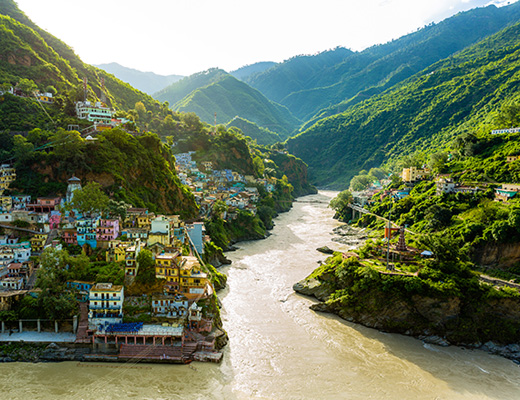
Note: *in US$ terms
Note: Conversion rate used in November 2023, Rs. 1 = US$ 0.012
References: Media Reports, Ministry of Tourism, Press Releases, Department for Promotion of Industry and Internal Trade (DPIIT), Press Information Bureau (PIB), Union Budget 2023-24, Economic Survey 2022-23
Related News
CRISIL forecasts Indian airlines to capture 50% of India's international air passenger traffic by FY28, up from 43% in the previous fiscal year.
Commerce Secretary Mr. Sunil Barthwal is in talks with New Zealand to enhance bilateral relations, emphasizing trade growth and cooperation in key sectors.
In 2023, Mizoram welcomed over 196,000 tourists, with Americans leading the foreign contingent, displaying the state's growing appeal and its commitment to responsible tourism.
The Indian Staffing Federation reports 3.6% growth in the staffing industry during Q3 FY24, driven by demand for a flexible workforce across key sectors like e-commerce, retail, and manufacturing.
Indian enthusiasm for global sports peaks as bookings rise 25-30%, reflecting rising incomes and youthful zeal, signalling a vibrant economy and aspirational culture.
States with Largest Domestic Tourist Arrivals in 2021
- Uttar Pradesh
- Andhra Pradesh
- Maharashtra

Industry Contacts
- Department of Tourism
- Palace on Wheels
- Hotel Association of India
- Federation of Hotel and Restaurant Associations of India

ANCIENT AND RICH
Approximately 8000 years old, India is the world's oldest surviving civilsation.
IBEF Campaigns

APEDA India Pavilion Gulfood February 20th-26th, 2022 | World Trade Centre,...

Ibef Organic Indian Pavilion BIOFACH2022 July 26th-29th, 2022 | Nuremberg, ...
Transforming India's Logistics Sector: Challenges and Opportunities

The logistics industry plays a vital role in the dynamic economic landscape of India by enabling the efficient movement of goods and services througho...
Promoting Indigenous Start-ups: Case Study of Investor Interest in Small-town Start-ups

As urban markets become saturated, investors are turning their gaze towards the untapped potential of small-town innovation, driven by a desire to fos...
India's White Revolution

The "White Revolution" in India refers to the successful implementation of Operation Flood, a dairy development program launched on January ...

Infrastructure Development: Indian Railways’ Plan for Enhanced Passenger Experience
In India's big web of transportation, Indian Railways is like an import...

India's Winning Move with PLI Initiatives
Considering its goal of becoming ‘Atmanirbhar’, India is workin...
India's Solar Power Revolution
India is leading the renewable energy revolution, with a strategic emphasis...

Not a member

- Country Reports
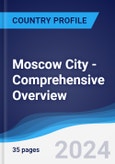
Moscow City - Comprehensive Overview, PEST Analysis and Analysis of Key Industries including Technology, Tourism and Hospitality, Construction and Retail
Country Profile
- February 2024
- ID: 5960446
- Description
Table of Contents
Related topics, related products.
- Purchase Options
- Ask a Question
- Recently Viewed Products
- The service sector remains the key contributor to the Moscow economy and the major employer.
- Moscow is a key tourist destination for both domestic and international tourists and experienced significant growth in its tourism sector, with sustained increases in the number of tourists visiting the city over the years. The city's commitment to modernizing infrastructure and its focus on global tourism trends have supported the growth of the tourism industry.
- The construction sector in the Moscow metropolitan area has seen steady growth in 2023. Despite challenges such as declining investment and geopolitical tensions, the sector output is expected to rebound in future, driven by government investments in infrastructure and residential projects. Significant construction projects are underway in Moscow, aims to meet the growing demand for office space and residential facilities in the city.
Reasons to Buy
- Gain a comprehensive knowledge of future economic and demographic trends and understand the performance of various sectors within the city.
- Analyze and understand the business environment in the city to align your investment and expansion strategies.
- The report helps to drive a conclusion in choosing a suitable city to invest or expand according to your business structure.
- Explore new opportunities in the hospitality, tourism, construction, real estate and retail sectors.
- About the Publisher
- Contact the Publisher

Moscow - Comprehensive Overview of the City, PEST Analysis and Analysis of Key Industries including Technology, Tourism and Hospitality, Construction and Retail
- Country Profile

Saint Petersburg City - Comprehensive Overview, PEST Analysis and Analysis of Key Industries including Technology, Tourism and Hospitality, Construction and Retail
- December 2023

Saint Petersburg - Comprehensive Overview of the City, PEST Analysis and Analysis of Key Industries including Technology, Tourism and Hospitality, Construction and Retail

Novosibirsk - Comprehensive Overview of the City, PEST Analysis and Analysis of Key Industries including Technology, Tourism and Hospitality, Construction and Retail

Russia - Macroeconomic Outlook Report
ASK A QUESTION
We request your telephone number so we can contact you in the event we have difficulty reaching you via email. We aim to respond to all questions on the same business day.
Request a Quote
YOUR ADDRESS
YOUR DETAILS
PRODUCT FORMAT
DOWNLOAD SAMPLE
Please fill in the information below to download the requested sample.
- LIVE DISCOURSE
- BLOG / OPINION
- SUBMIT PRESS RELEASE
- Advertisement
- Knowledge Partnership
- Media Partnership
- Urban Development
Government Incentives for Economic Growth: Infrastructure Status for Hospitality and HAI for Industry
India's hospitality sector seeks industry status at state level and infrastructure status from the centre to attract investments and develop new tourist destinations. the sector expects tourist arrivals to reach pre-pandemic levels by march 2025 but emphasizes the need for easier visa procedures and global promotion campaigns. industry status would provide benefits such as lower power tariffs and interest rates, while infrastructure status would allow for more international investment. if these measures are not implemented, growth in the sector will be limited. the sector aims to capitalize on india's economic growth and increased air travel to boost its performance..

There is an urgent need for the hospitality sector to be granted industry status at state level and infrastructure by the Centre for it to attract more investments and play a part in the development of 50 new destinations announced by the government, according to newly elected president of Hotel Association of India (HAI), KB Kachru.
The sector is also hopeful that international tourist arrivals in India will reach pre-pandemic levels by March next year but ease of getting visas needs to be facilitated, while also taking up campaigns to promote the country as a destination globally.
''The government has declared 50 new destinations. Investors will be interested to invest money in these destinations if the infrastructure is there,'' Kachru, who is also Chairman -- South Asia, Radisson Hotel Group, told PTI.
He further said,''People will only invest money if the related incentives are given...Unless the industry is motivated to invest in these destinations, we will not achieve what we want.'' Kachru asserted that the hospitality sector is not ''asking for subsidies or things which are difficult for the government''.
''What we are saying is that whatever is the wish for the government, how can we contribute?...What we are saying is that treat us at state level as part of industry like any other such as manufacturing...If we are treated like that at state level, we will get all the related benefits and we can grow.'' In the absence of industry status in many states, the hospitality sector is treated as a commercial sector resulting in much higher power tariff and interest rates on borrowings.
At the central level, he said,''We have been asking for infrastructure status...what will happen as a result of it is that we will be able to attract investments, not only domestically but in a big way internationally. We can borrow money at a reasonable interest with infrastructure status which at the moment is not allowed.'' This will motivate international investments to come into India. This is a kind of direct incentive to people to assure that their investment is safe, Kachru added.
He noted that while airports are given infrastructure status, hotels are not, and if there are not enough accommodation and facilities for people to stay it would be difficult for a destination to grow.
When asked if the industry status at state level and infrastructure at the central level is not forthcoming, what could be the impact, he said,''The growth of the hospitality and tourism sector would move very organically because we are developing and positioning in a manner that we have an opportunity here.'' ''Sometimes you use the opportunity the right way. It is for us to take a big leap forward,'' he said while pointing at the possibility of missed opportunities for the sector.
Kachru, however, acknowledged ''we have been seeing a lot of change and positiveness amongst all stakeholders -- states and Centre.'' On inbound tourist arrivals, he said,''We are hoping to catch up to 2019 (levels)...Our aim is to reach the pre-pandemic level by March 2025.'' As per estimates, foreign tourist arrivals in India in 2019 was nearly 1.1 crore.
Kachru, however, said a lot of work has to be done in terms of marketing India and facilitating ease of visas to attract more foreign tourists.
There has to be a dedicated action plan internationally to promote India, promote more incoming flights and ease of getting visas, he added.
When asked about the overall growth outlook for the hospitality sector, he said,''With the economic growth of 7 per cent that we are talking about, our industry is looking for even better growth. With so many new aircraft coming in across different airlines, there would be more travel.''
World Bank suspends Tanzania tourism fund over abuse allegations
Moscow city tourism committee organizes conference for indian mice market stakeholders, religious tourism spots like varanasi and ayodhya may soon outshine goa and agra, us prioritizes student visas, envoy predicts sustained growth, afghanistan: taliban aim to develop tourism industry.

European shares hit one-month high as earnings take centre stage

"400 paar' is slogan of public, Congress can't suppress it": Gujarat HM Hars...

Colombian maritime companies hit with US visa curbs over migrant transport

Infosys Earns Prestigious ISO 42001:2023 Certification for Artificial Intell...
Latest news, exclusive-brazil's suzano readies $15 billion bid for international paper, sources say, us congressional negotiators strengthen airline refund provision, us stocks-s&p, dow end slightly up, extend closing streaks despite disney drag, brief-the oxford-astrazeneca covid vaccine is being withdrawn worldwide- the telegraph.

OPINION / BLOG / INTERVIEW
Green metropolises: navigating the path to sustainable urban growth globally, the creative frontier: unleashing potential with generative ai, customized minds: the ai revolution in learning and behavioral change, transformative strategies for high-density cities, connect us on.
- ADVERTISEMENT
- KNOWLEDGE PARTNERSHIP
- MEDIA PARTNERSHIP
- Agro-Forestry
- Art & Culture
- Economy & Business
- Energy & Extractives
- Law & Governance
- Science & Environment
- Social & Gender
- East and South East Asia
- Europe and Central Asia
- Central Africa
- East Africa
- Southern Africa
- West Africa
- Middle East and North Africa
- North America
- Latin America and Caribbean
OTHER LINKS
- Write for us
- Submit Press Release
- Opinion / Blog / Analysis
- Business News
- Entertainment News
- Technology News
- Law-order News
- Lifestyle News
- National News
- International News
OTHER PRODUCTS
Email: [email protected] Phone: +91-720-6444012, +91-7027739813, 14, 15
© Copyright 2024
- Travel, Tourism & Hospitality
Industry-specific and extensively researched technical data (partially from exclusive partnerships). A paid subscription is required for full access.
Global market size of the hospitality industry 2023-2029
Market size of the hospitality industry worldwide in 2023, with forecasts for 2024 and 2029 (in billion u.s. dollars).
- Immediate access to 1m+ statistics
- Incl. source references
- Download as PNG, PDF, XLS, PPT
Additional Information
Show sources information Show publisher information Use Ask Statista Research Service
January 2024
Other statistics on the topic Hotel industry worldwide
Accommodation
- Monthly hotel occupancy rates worldwide 2020-2023, by region
- Sales of biggest global hotel and resort companies 2023
- Most valuable hotel brands worldwide 2023, by brand value
- Global hotel and resort industry market size worldwide 2013-2023
To download this statistic in XLS format you need a Statista Account
To download this statistic in PNG format you need a Statista Account
To download this statistic in PDF format you need a Statista Account
To download this statistic in PPT format you need a Statista Account
As a Premium user you get access to the detailed source references and background information about this statistic.
As a Premium user you get access to background information and details about the release of this statistic.
As soon as this statistic is updated, you will immediately be notified via e-mail.
… to incorporate the statistic into your presentation at any time.
You need at least a Starter Account to use this feature.
- Immediate access to statistics, forecasts & reports
- Usage and publication rights
- Download in various formats
You only have access to basic statistics. This statistic is not included in your account.
- Instant access to 1m statistics
- Download in XLS, PDF & PNG format
- Detailed references
Business Solutions including all features.
Statistics on " Hotel industry worldwide "
- Hotel openings worldwide 2021-2024
- Hotel room openings worldwide 2021-2024
- Monthly occupancy rate of hotels worldwide 2020-2023
- Change in monthly number of hotel bookings worldwide 2020-2023
- Change in monthly number of hotel bookings worldwide 2020-2023, by region
- Market value of biggest global hotel and resort companies 2023
- Leading hotel brands in the world 2022, by traveler ratings
- Change in monthly number of online hotel searches worldwide 2020-2023, by region
- Technologies global hotels plan to implement in the next three years 2022
- COVID-19 hotel technologies or services that global consumers want long-term 2022
- Hotel technologies global consumers think would improve their future stay 2022
- Guests interested in touring hotels using VR/metaverse technology worldwide 2022
- Guests interested to stay at hotels with automated messaging/chatbots worldwide 2022
- Guests more likely to stay at hotels with self-service technology worldwide 2022
- Countries with the most hotel construction projects in the pipeline worldwide 2022
- Countries with the largest amount of hotel rooms in the construction pipeline 2022
- Cities with the most lodging projects in the pipeline worldwide 2022
- Cities with the largest amount of lodging rooms in the pipeline worldwide 2022
- Number of rooms in the pipeline worldwide 2022, by company
Other statistics that may interest you Hotel industry worldwide
Industry overview
- Premium Statistic Global hotel and resort industry market size worldwide 2013-2023
- Premium Statistic Hotel openings worldwide 2021-2024
- Premium Statistic Hotel room openings worldwide 2021-2024
- Premium Statistic Monthly occupancy rate of hotels worldwide 2020-2023
- Premium Statistic Monthly hotel occupancy rates worldwide 2020-2023, by region
- Premium Statistic Change in monthly number of hotel bookings worldwide 2020-2023
- Premium Statistic Change in monthly number of hotel bookings worldwide 2020-2023, by region
Key players
- Premium Statistic Market value of biggest global hotel and resort companies 2023
- Premium Statistic Sales of biggest global hotel and resort companies 2023
- Premium Statistic Most valuable hotel brands worldwide 2023, by brand value
- Basic Statistic Leading hotel brands in the world 2022, by traveler ratings
Digitalization
- Premium Statistic Change in monthly number of online hotel searches worldwide 2020-2023, by region
- Premium Statistic Technologies global hotels plan to implement in the next three years 2022
- Premium Statistic COVID-19 hotel technologies or services that global consumers want long-term 2022
- Premium Statistic Hotel technologies global consumers think would improve their future stay 2022
- Premium Statistic Guests interested in touring hotels using VR/metaverse technology worldwide 2022
- Premium Statistic Guests interested to stay at hotels with automated messaging/chatbots worldwide 2022
- Premium Statistic Guests more likely to stay at hotels with self-service technology worldwide 2022
Construction outlook
- Premium Statistic Countries with the most hotel construction projects in the pipeline worldwide 2022
- Premium Statistic Countries with the largest amount of hotel rooms in the construction pipeline 2022
- Premium Statistic Cities with the most lodging projects in the pipeline worldwide 2022
- Premium Statistic Cities with the largest amount of lodging rooms in the pipeline worldwide 2022
- Premium Statistic Number of rooms in the pipeline worldwide 2022, by company
Further related statistics
- Premium Statistic Number of hotel and catering businesses in Bruges (Belgium) 2012-2018
- Premium Statistic Revenue of the hospitality industry in the Netherlands 2008-2020
- Premium Statistic Number of hotel and catering businesses in Brussels (Belgium) 2012-2018
- Premium Statistic Revenue of the hospitality industry in the Netherlands 2016-20120by type
- Premium Statistic Number of hotel and catering businesses in Liège (Belgium) 2012-2018
- Premium Statistic Number of hotel and catering businesses in Antwerp city (Belgium) 2012-2018
- Premium Statistic Migrant workforce in the hospitality sector in England 2016, by region
- Premium Statistic Consumer usage of foodservices Belgium 2017, by moment of the day
- Premium Statistic Distribution of migrant workers in hospitality in the UK 2011-2016, by industry
- Basic Statistic Hospitality sector: VAT rates in Belgium 2013
- Basic Statistic Hospitality sector: VAT rates in Croatia 2013
- Premium Statistic Direct employment in hospitality in the United Kingdom (UK) 2016. by sector
- Basic Statistic Hospitality sector: VAT rates in Cyprus 2013
- Basic Statistic Revenue index of the hospitality industry in the Netherlands Q3 2018-Q4 2023
- Premium Statistic Volume changes in the leisure industry in the Netherlands 2015-2020
- Premium Statistic Popular open source positions according to hiring managers worldwide 2020
- Premium Statistic Global nitrile butadiene rubber latex market value 2019 & 2026
- Premium Statistic Kloeckner & Co. SE - shipments 2005-2021
- Premium Statistic Annual diesel-electric rubber-tired gantry (RTG) crane CO2 emissions 2017
- Basic Statistic Crocs' retail revenue worldwide 2018-2021, by region
Further Content: You might find this interesting as well
- Number of hotel and catering businesses in Bruges (Belgium) 2012-2018
- Revenue of the hospitality industry in the Netherlands 2008-2020
- Number of hotel and catering businesses in Brussels (Belgium) 2012-2018
- Revenue of the hospitality industry in the Netherlands 2016-20120by type
- Number of hotel and catering businesses in Liège (Belgium) 2012-2018
- Number of hotel and catering businesses in Antwerp city (Belgium) 2012-2018
- Migrant workforce in the hospitality sector in England 2016, by region
- Consumer usage of foodservices Belgium 2017, by moment of the day
- Distribution of migrant workers in hospitality in the UK 2011-2016, by industry
- Hospitality sector: VAT rates in Belgium 2013
- Hospitality sector: VAT rates in Croatia 2013
- Direct employment in hospitality in the United Kingdom (UK) 2016. by sector
- Hospitality sector: VAT rates in Cyprus 2013
- Revenue index of the hospitality industry in the Netherlands Q3 2018-Q4 2023
- Volume changes in the leisure industry in the Netherlands 2015-2020
- Popular open source positions according to hiring managers worldwide 2020
- Global nitrile butadiene rubber latex market value 2019 & 2026
- Kloeckner & Co. SE - shipments 2005-2021
- Annual diesel-electric rubber-tired gantry (RTG) crane CO2 emissions 2017
- Crocs' retail revenue worldwide 2018-2021, by region

Atmosphere Core’s stellar lineup: 4 for 2024
I nternational hospitality company, Atmosphere Core is experiencing a year of phenomenal growth with the launch of ‘RAAYA by Atmosphere’ in the Maldives and three properties opening in India this year. The company’s extensive resort management experience creates a strong base for expanding into South Asia and beyond.
Salil Panigrahi, Managing Director of Atmosphere Core comments on the expansion into India and brand strengths: “One of our strengths is our strong brand portfolio, which we are now bringing into India. Atmosphere Hotels & Resorts is our legacy, and our original company name is now a powerful brand that paves the way for refreshingly different destinations. While THE OZEN COLLECTION elevates guest experiences through bespoke service, sophisticated gastronomy, finest Champagne and wines and enriching wellness experiences. Our third brand, COLOURS OF OBLU is an experience collective with Vibrant Destinations that awaken the senses, bring balance and provide the gift of lifetime memories.”
Atmosphere Core recently took over the management of Kudakurathu island in Raa Atoll, Maldives. With the rebranding as ‘RAAYA by Atmosphere’ set for completion by July 4, 2024, this is the third Atmosphere Hotels & Resorts island in the Maldives, and tenth globally. Balancing adventure and relaxation, the 167-villa resort features six picturesque dining choices, ELE|NA spa and a host of outdoor adventures including an art studio, a mini-golf course, a skating park and a mangrove walkway.
At RAAYA by Atmosphere, the unique ‘RAAYA Plan’ blends a stay with the finest world cuisine, premium and exclusive beverages, spa and wellness therapies, ocean experiences, island adventures for the family and curated artistic interludes. “A highlight is our innovative activities that kids and parents can enjoy together, such as the wooden Dhoni building workshop. These elevated guest experiences will be delivered with an unparalleled level of service at every touchpoint. I am confident that our brand’s ethos of ‘A New Experience Awaits’ will resonate with discerning global travellers and ensure remarkable success,” adds Stéphane Laguette, the Chief Commercial Officer at Atmosphere Core.
Under Salil Panigrahi’s leadership, Atmosphere Core has forged new standards for hospitality in the Maldives, and this legacy is set to continue globally. The Atmosphere Hotels & Resorts brand will mark a presence in India with two exciting new destinations opening in Q3 2024. Sadar Manzil is a heritage gem in the heart of Bhopal’s walled city. Renovated to blend modern luxuries with intricate heritage architecture, SADAR MANZIL HERITAGE BY ATMOSPHERE BHOPAL offers guests 22 suites, a multi cuisine restaurant, a spa and wellness centre and a wine tasting room.
Also opening this year, in a pristine 40-acre coffee plantation, is the serene STILLWOOD RETREAT A SIGNATURE ATMOSPHERE COORG. This 42-villa sanctuary features a refined all-day dining experience, a wine lounge, a themed bar, a captivating library and a versatile event space – all framed by picturesque views. After a day of thrilling hiking and nature exploration, guests can surrender to wellness therapies at ELE|NA spa by the lake.
THE OZEN COLLECTION will debut on September 12, 2024 with OZEN MANSION KOLKATA – an impressive, stately hotel nestled within six acres of lush gardens in Kolkata’s prime New Town area. The flagship resort will offer 235 lavish rooms and suites, impressive lounges, exotic dine around, a spa and wellness centre, and extensive event spaces.
We have updated our terms and conditions and privacy policy Click "Continue" to accept and continue with ETHRWorld
We use cookies to ensure best experience for you
We use cookies and other tracking technologies to improve your browsing experience on our site, show personalize content and targeted ads, analyze site traffic, and understand where our audience is coming from. You can also read our privacy policy , We use cookies to ensure the best experience for you on our website.
By choosing I accept, or by continuing being on the website, you consent to our use of Cookies and Terms & Conditions .
- SouthEast Asia
- The Middle East
- Leaders Speak
- Brand Solutions
- Hospitality, oil & gas, FMCG sectors see surge in hiring in India
The hospitality and travel sector witnessed a 16 per cent growth, driven by the strong momentum in travel and tourism, according to the 'Naukri JobSpeak Index'.
- Updated On May 7, 2024 at 04:46 PM IST
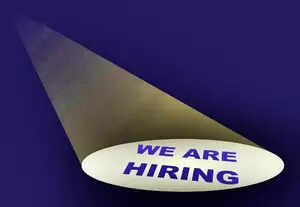
- Published On May 7, 2024 at 04:44 PM IST
All Comments
By commenting, you agree to the Prohibited Content Policy
Find this Comment Offensive?
- Foul Language
- Inciting hatred against a certain community
- Out of Context / Spam
Join the community of 2M+ industry professionals
Subscribe to our newsletter to get latest insights & analysis., download ethrworld app.
- Get Realtime updates
- Save your favourite articles
- hospitality
- job creation
- Naukri JobSpeak Index

IMAGES
COMMENTS
The projected growth of the global hospitality market is set to soar to a staggering $5,816.66 billion by 2027, with a remarkable compound annual growth rate (CAGR) of 5.5%. ... The growth of the travel and tourism sector has been influenced by several factors including ease of access to information, an increase in the amount of paid leave, and ...
Travel, Tourism & Hospitality. Total contribution of travel and tourism to GDP worldwide 2019-2033. Travel, Tourism & Hospitality ... Inbound tourism visitor growth worldwide from 2020 to 2022 ...
10 hospitality trends 2024 - Elevate experiences, embrace evolution. Workforce empowerment: Transforming challenges into opportunities. Artificial intelligence and technology: Choosing the best tech to revolutionize hospitality. Culinary experiences: Putting experiences, authenticity and the senses first.
10 Nov 2023. Tourism has again been identified as a key driver of economic recovery and growth in a new report by the International Monetary Fund (IMF). With UNWTO data pointing to a return to 95% of pre-pandemic tourist numbers by the end of the year in the best case scenario, the IMF report outlines the positive impact the sector's rapid ...
Longer-term forecasts also point to optimism for the decade ahead. Travel and tourism GDP is predicted to grow, on average, at 5.8 percent a year between 2022 and 2032, outpacing the growth of the overall economy at an expected 2.7 percent a year. 5 Travel & Tourism economic impact 2022, WTTC, August 2022.
The Travel & Tourism market worldwide is projected to grow by 3.47% (2024-2028) resulting in a market volume of US$1,063.00bn in 2028. ... Tourism & Hospitality ... This has led to the growth of ...
Tourism made up 10 percent of global GDP in 2019 and was worth almost $9 trillion, 1 See "Economic impact reports," World Travel & Tourism Council (WTTC), wttc.org. making the sector nearly three times larger than agriculture. However, the tourism value chain of suppliers and intermediaries has always been fragmented, with limited coordination among the small and medium-size enterprises ...
Industry Definition. The travel and tourism sector comprises a wide range of products and services, including leisure and business travel, accommodation, food and drink services, and more. Some of ...
United States Hospitality Market Analysis. The hospitality industry in the United States has been growing, with the rising number of international travelers visiting the country for leisure trips and with the rising business travel within the country. The total value of bookings increased from USD 116 billion in 2009 to USD 185 billion in 2017.
They will be more likely to survive and thrive. As an ex-strategy consultant and public speaker on digital and technology trends, and now running venture-backed, travel-tech startup Beyonk, here ...
While few segments of the economy were spared, hospitality and tourism were particularly hard hit. The WTTC reported that the sector lost $4.5 trillion in 2020, with its contribution to GDP plummeting 49.1 percent, compared with just a 3.7 percent decline in the overall global economy. While COVID-19 has caused significant disruption, the ...
The hospitality industry continues to be a strong pillar of the global economy, providing employment opportunities to many and contributing significantly to economic growth and stability. According to the World Travel & Tourism Council , before the pandemic, the hospitality industry accounted for about 1 in 4 jobs created worldwide, 10.3% of ...
The tourism and hospitality industry is one of the fastest-growing industries in the world, providing a colossal number of job opportunities. Between 2021 and 2031, employment in the hospitality and tourism industry is projected to expand faster than any other job sector, creating about 1.3 million new positions.
The Indian travel and tourism ...
The Medical Tourism sector ...
Dubai welcomed 5.18 million international overnight visitors from January to March 2024, an 11 percent rise over the 4.67 million tourist arrivals during the same period in 2023, the Dubai Department of Economy and Tourism (DET) said at the 31st edition of Arabian Travel Market (ATM) on Monday.. Following a milestone year in 2023, with Dubai receiving a record 17.15 million international ...
Accor is proud to have participated to the Future Hospitality Summit, which returned to Saudi Arabia this year, bringing together the Kingdom's leading industry experts. From 2022 to 2032, the growth rate in the GCC's tourism sector is projected to be 13.6% with a potential market value of 65.5 billion USD. Accor, firmly rooted in the Middle East, responds to the dynamic shifts in travel ...
Travel, Tourism & Hospitality ... this figure saw growth in 2022 and was forecast to reach 1.21 trillion U.S. dollars by 2023. What are the biggest hotel companies in the world? Some of the key ...
Moscow City - Comprehensive Overview, PEST Analysis and Analysis of Key Industries including Technology, Tourism and Hospitality, Construction and Retail ... Moscow is a key tourist destination for both domestic and international tourists and experienced significant growth in its tourism sector, with sustained increases in the number of ...
Recent data from global research companies indicates a bright future for the GCC hospitality industry, with insights from Deloitte and STR demonstrating sustained growth as tourism continues to be ...
India's hospitality sector seeks industry status at state level and infrastructure status from the Centre to attract investments and develop new tourist destinations. The sector expects tourist arrivals to reach pre-pandemic levels by March 2025 but emphasizes the need for easier visa procedures and global promotion campaigns. Industry status would provide benefits such as lower power tariffs ...
The rapid growth of tourism is one of the key trends in the development of the modern city. In 2011-2019, the annual average growth rate was a record 7.2 per cent-one and a half times more than in the world (4.6 per cent). ... The tourism and hospitality industry includes more than 50 segments, and its development depends on overall ...
This figure is projected to reach $31.01 billion by 2029, reflecting a compound annual growth rate (CAGR) of 4.73 per cent [Mordor Intelligence: Hospitality Industry In India Market Size]. This ...
Minister of Tourism and International Transport, Ian Gooding-Edghill, speaking after day one of the Third Regional Meeting of Directors and Heads of Maritime Administrations at the Accra Beach and Spa. (J. Bishop/BGIS) Minister of Tourism and International Transport, Ian Gooding-Edghill, has attributed the reported growth in the island's tourism sector to Bajan hospitality. Mr. Gooding ...
The hospitality and travel sector witnessed a 16 per cent growth, driven by the strong momentum in travel and tourism, according to the 'Naukri JobSpeak Index'. Positions like front office managers, housekeeping supervisors and F&B service professionals were in high demand across urban hubs like ...
It encompasses many industries, the largest of which are accommodation and food and drink services. In 2023, the global hospitality market reached over 4.7 trillion U.S. dollars and was forecast ...
Travel & Tourism News 55m I nternational hospitality company, Atmosphere Core is experiencing a year of phenomenal growth with the launch of 'RAAYA by Atmosphere' in the Maldives and three ...
The hospitality and travel sector witnessed a 16 per cent growth, driven by the strong momentum in travel and tourism, according to the 'Naukri JobSpeak Index'. Positions like front office managers, housekeeping supervisors and F&B service professionals were in high demand across urban hubs like Delhi, Mumbai, and Bengaluru.
IAC posted mixed financial results for the March quarter, highlighted by the first quarter of revenue growth at its Dotdash Meredith publishing unit since the company acquired the Meredith ...